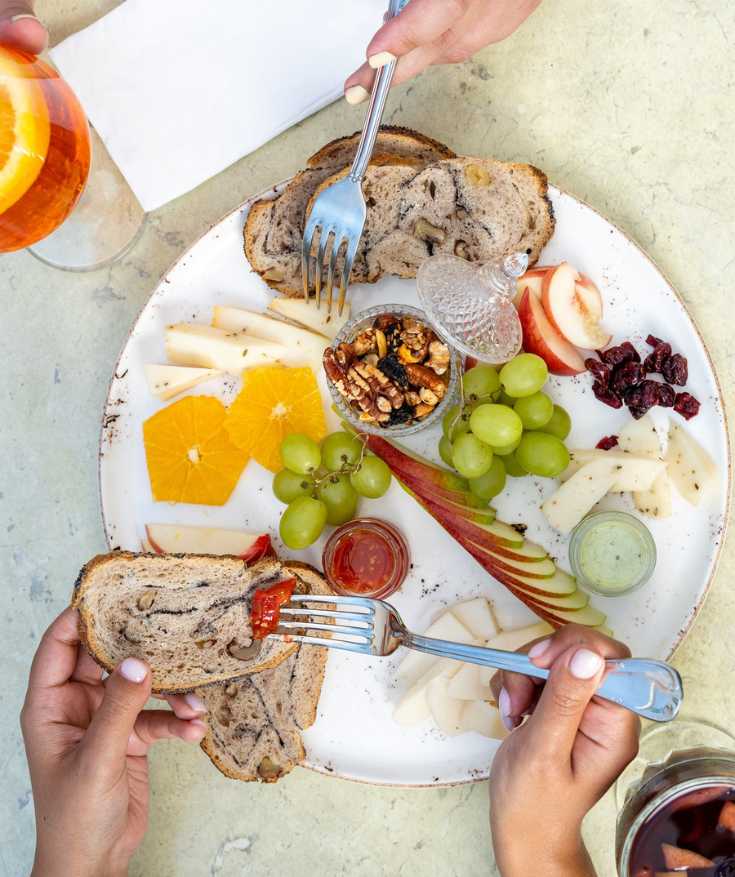Bite into Singapore’s rich culinary landscape through these 39 traditional Singapore food
These are the top Singapore food and dishes you must try for your trip to SG: flavors of the Lion City with historical backgrounds that shape Singapore’s gastronomic spectrum.
One of the main reasons that I stayed in Singapore for one month was the food. At first, I thought I would spend so much (knowing that this is an expensive Asian city).
With the hundreds of Hawker centres all over the city, not only did I save money but I also got to know Singapore food better.
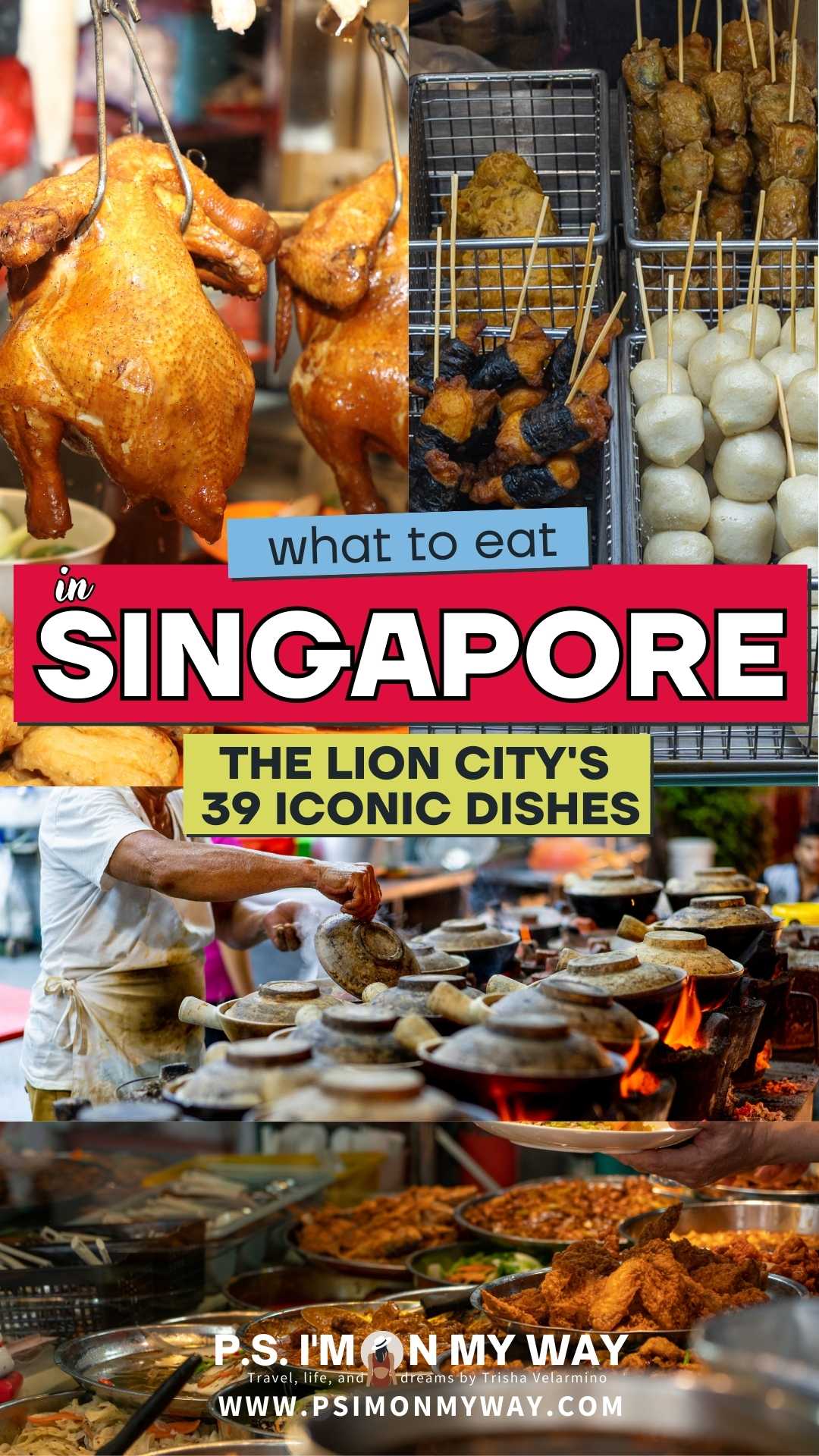
The focus of my trips is always on food, and believe me, Singapore food is unique as it is a fusion of all of its neighbors (China, India, Malaysia, Brunei, etc).
If you are traveling to Singapore, this is a comprehensive list of the best dishes to try, including what to know about the regional cuisines and food culture in SG.
Change how you travel and see the world by going deep into the culture. Come and travel with me!
🍲 Singapore food culture
Singapore food culture is a vibrant tapestry woven from its diverse ethnic fabric and rich history. As a major trading port, it became a melting pot of culinary traditions from China, India, Malaysia, and beyond.
Hawker centers, the heart and soul of Singaporean gastronomy, echo with the symphony of sizzling woks, aromatic spices, and animated chatter.
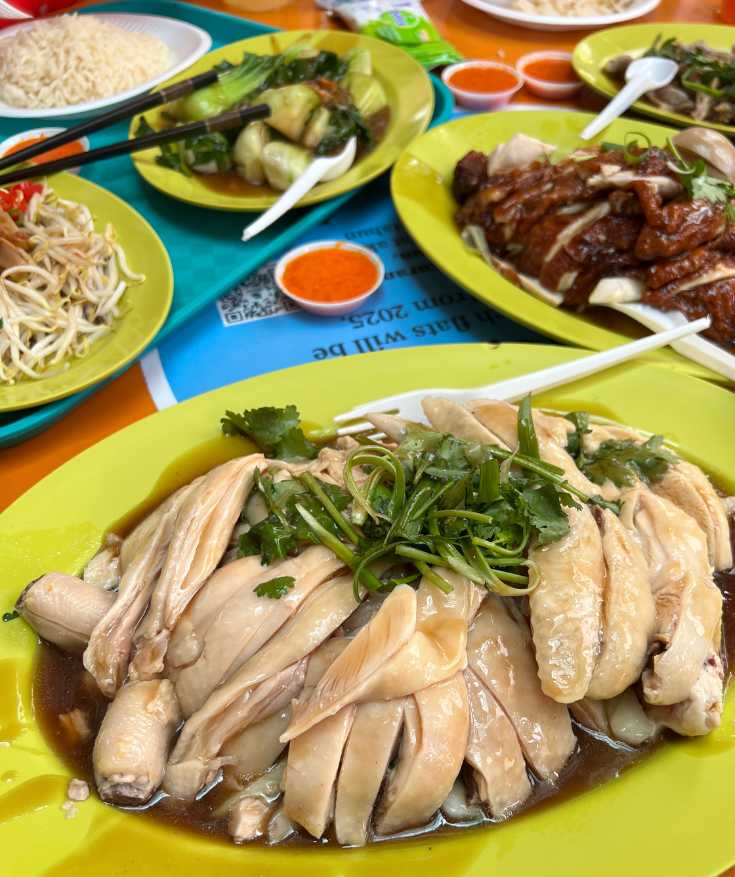

Here, one can trace the multicultural narrative of the city-state: from the fragrant spices of Malay rendang to the savory depth of Chinese Hainanese chicken rice, the fiery tang of Indian curries, to the unique fusion of Peranakan dishes.
Food isn’t just sustenance; it’s a communal experience, a shared joy, and a testament to the harmonious multicultural identity of Singaporean food.
Singapore food is not just about flavors but also stories of migration, adaptation, and innovation.
😋 Top 5 Singapore food staples
Singapore food scene is a melting pot of various cultures, with some staples frequently enjoyed by locals and tourists alike.
Here are five staples of Singapore food:
Rice
Central to many dishes, rice is a primary staple in Singapore.
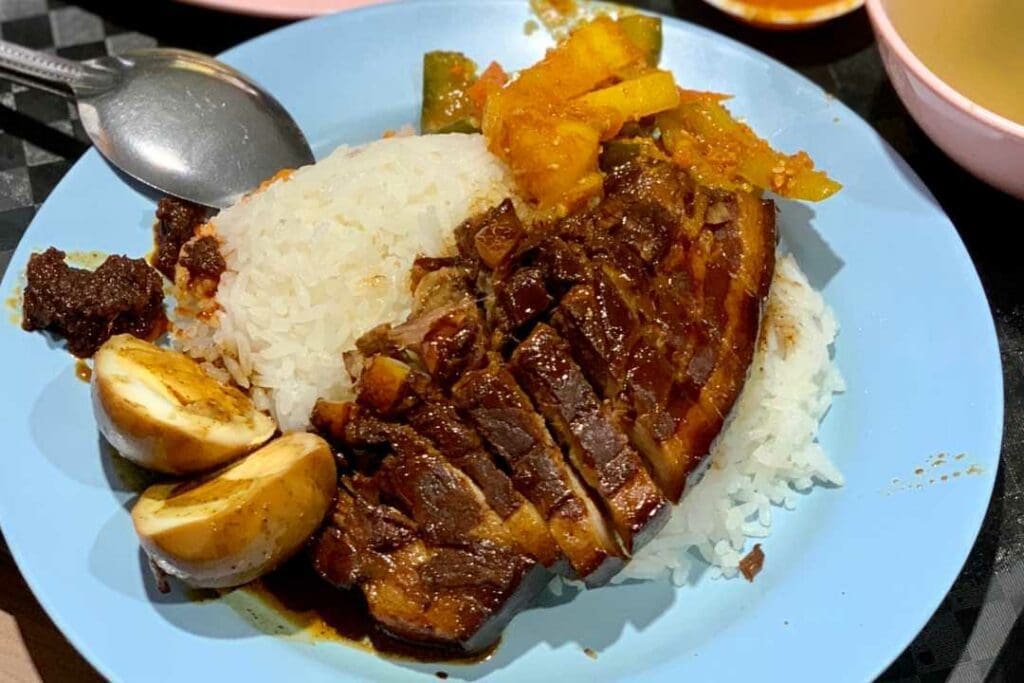

Examples include Hainanese Chicken Rice (where the rice is cooked in chicken broth) and Nasi Lemak (coconut milk rice).
Noodles
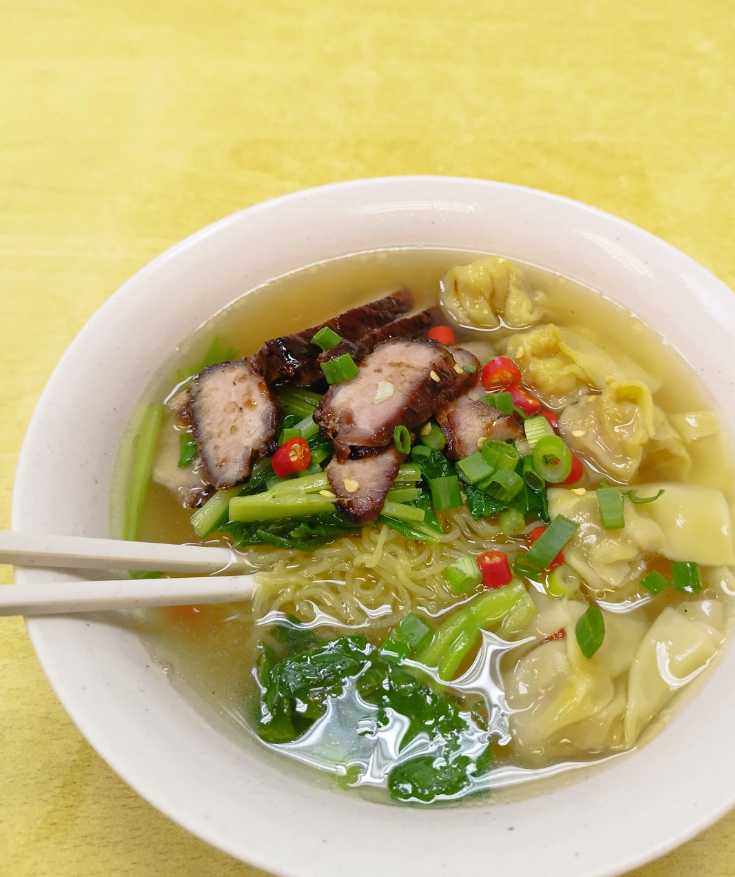

Many Singapore food and dishes are noodle-based, such as Char Kway Teow (stir-fried flat rice noodles), Hokkien Mee (stir-fried prawn noodles), and Laksa (spicy noodle soup).
Seafood
Given Singapore’s location, seafood plays a significant role in its culinary landscape.
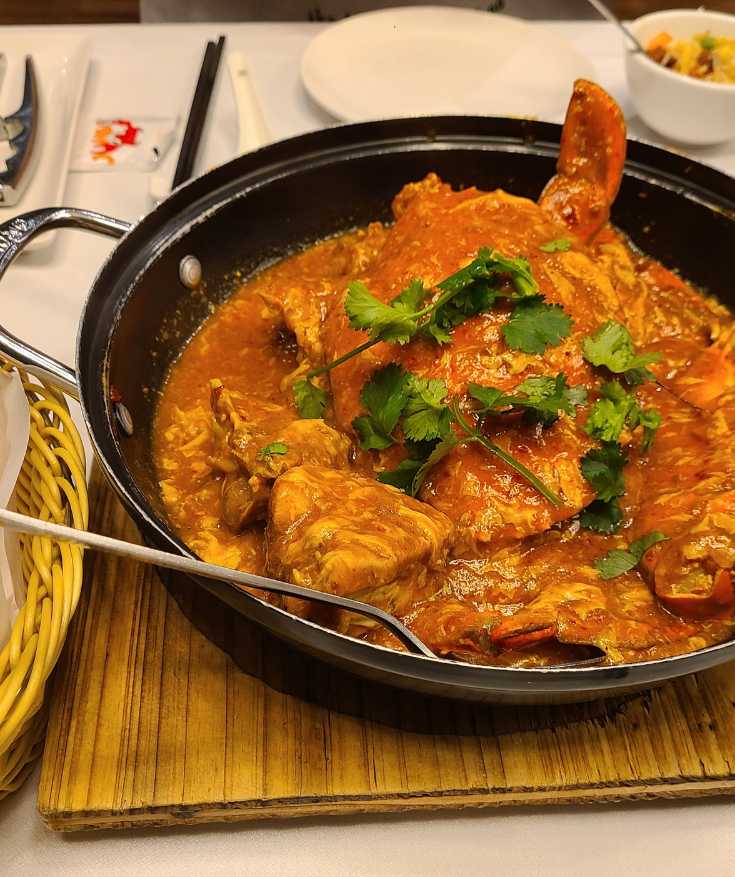

Chilli Crab and Black Pepper Crab are among the favorite seafood dishes.
Meat (especially chicken)
Various forms of meat are staples, but chicken is especially prevalent.
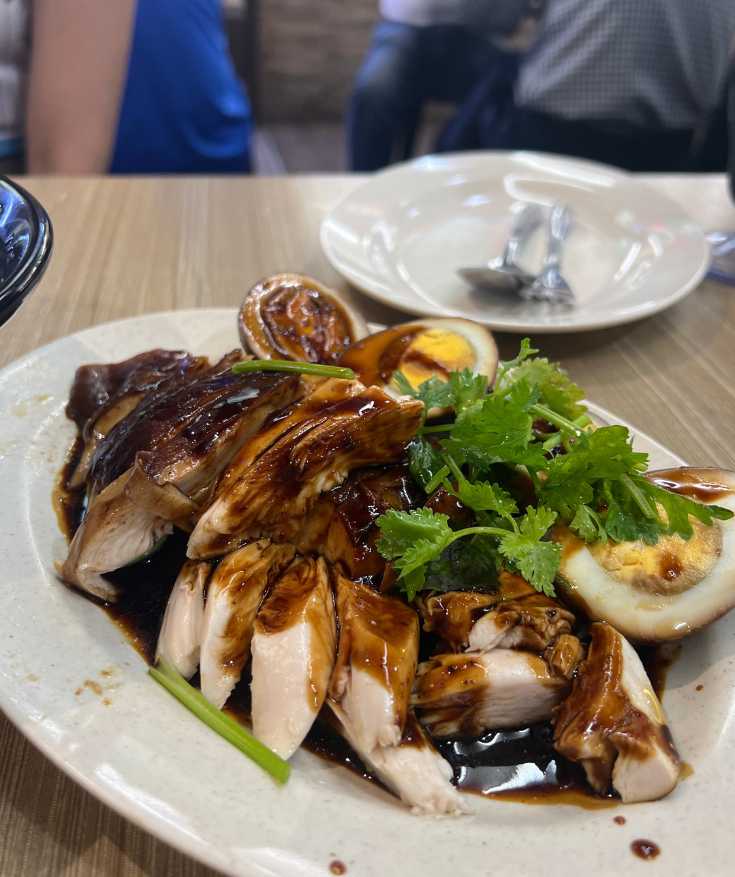

Dishes like Hainanese Chicken Rice, Satay (grilled skewered meat), and Curry Chicken are popular.
Tofu and Bean Products
These are frequently used in dishes like Tau Huay (soft soybean curd dessert), Yong Tau Foo (a Hakka Chinese cuisine consisting primarily of tofu filled with ground meat mixture or fish paste), and in various soups and stews.
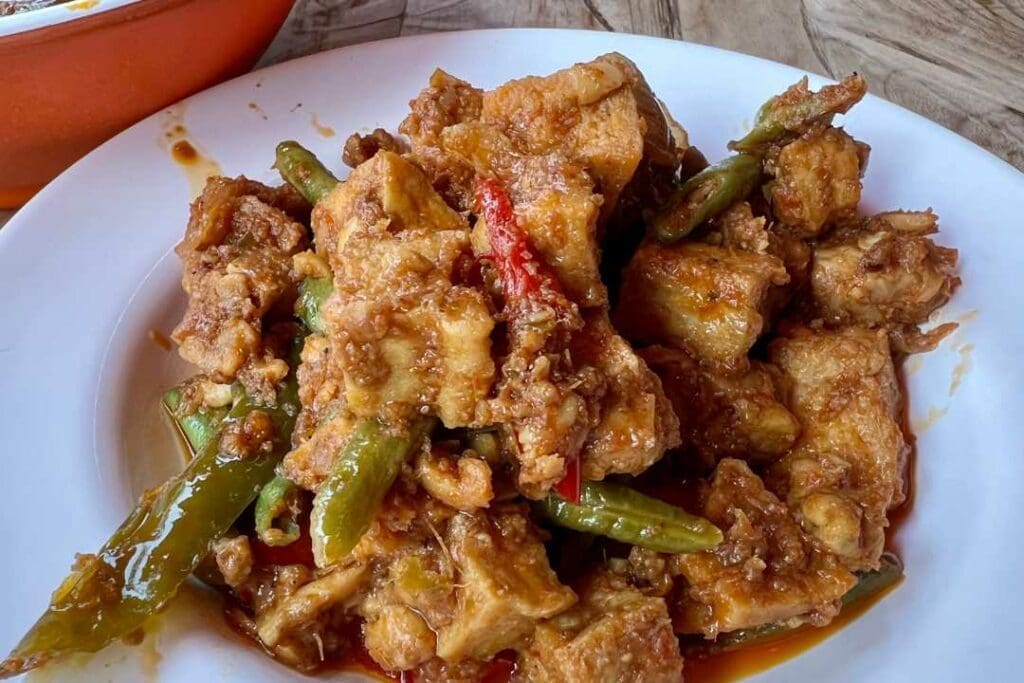

These staples reflect Singapore’s multicultural heritage, drawing influences from Malay, Chinese, Indian, and other cuisines.
🗺️ Map of Singapore food (where to find them)
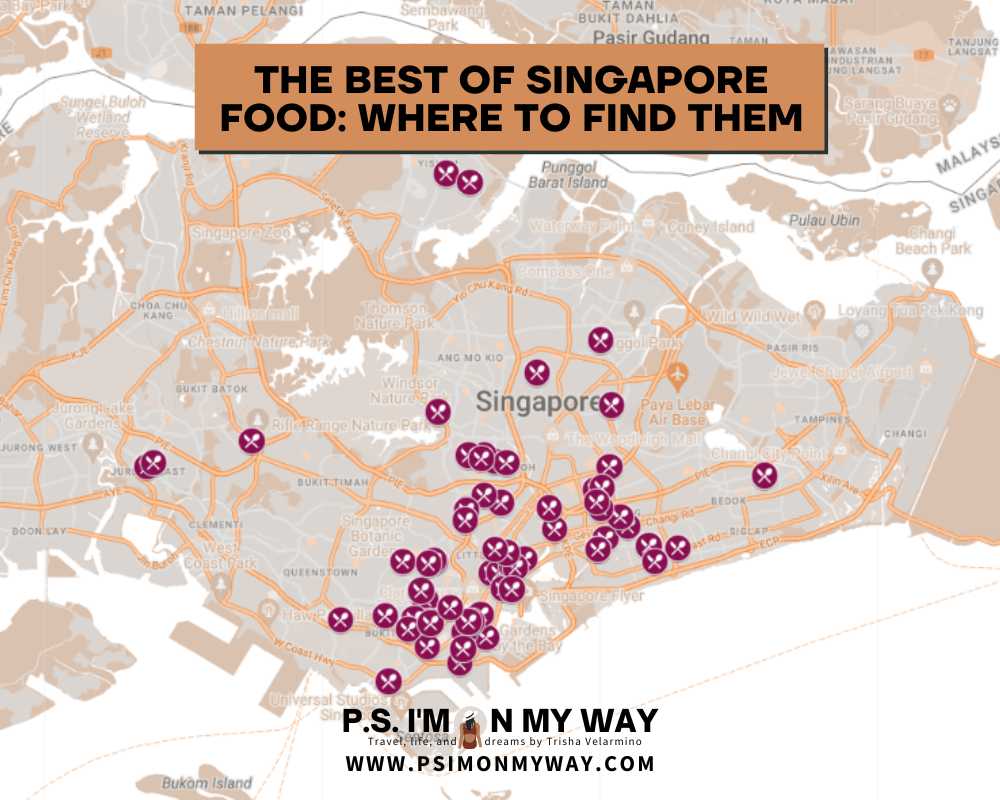

🍛 Best of Singapore food
1. Cendol
Cendol is a lush dessert, an icy blend crowned with green pandan jelly, swimming in coconut milk and decadently sweet palm sugar.
This cooling concoction is a harmonious interplay of textures and sweetness, making it a favorite treat in Singapore’s sweltering heat.
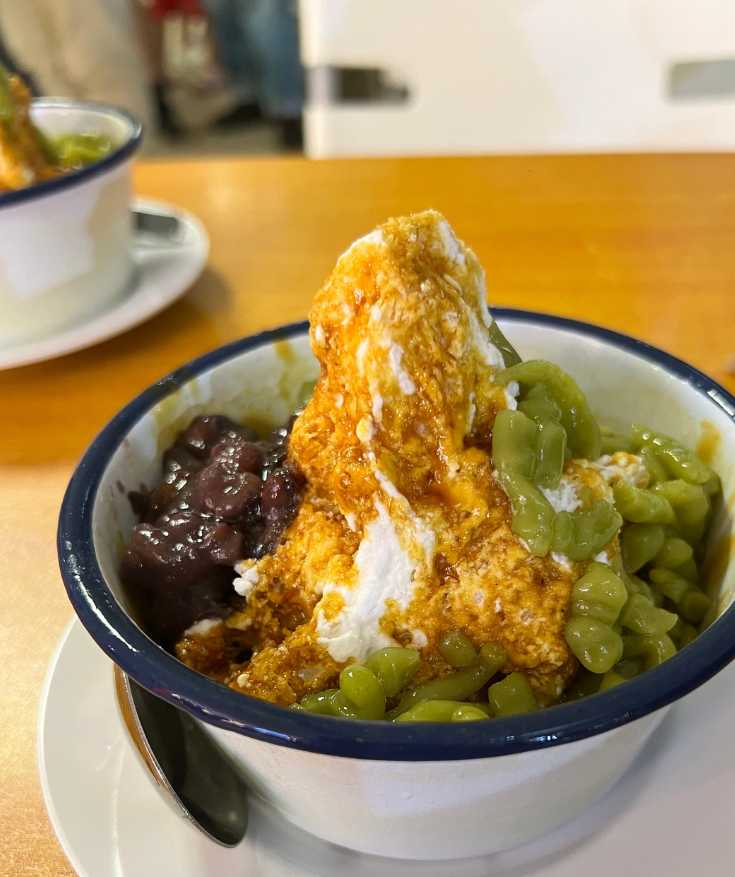

Originating from the word “jendol” in Javanese (meaning “bulge” or “swell”), Chendol might’ve begun its journey in Indonesia.
It swiftly became a Southeast Asian sensation, and with waves of migration, Singapore added its own unique touches, securing its place as a street-food legacy.
📍 Where to eat Cendol in Singapore: Yatkayan Desert and Nyonya Chendol
2. Sambal Kangkong
Water spinach meets a fiery sambal belacan in Sambal Kangkong, creating a spicy, umami-filled delight. The leafy greens are stir-fried with the spicy shrimp paste, rendering an aromatic, bold dish.
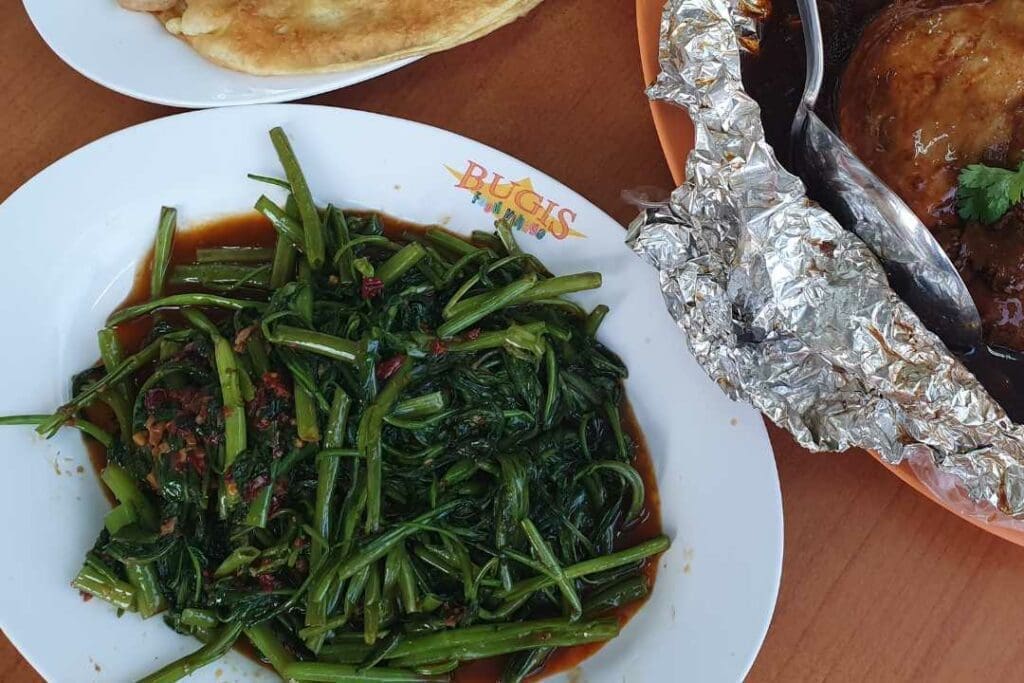

With roots stretching back to Malay cuisine, the dish echoes Singapore’s time-old connection to the Malay Peninsula.
Over time, the island’s diverse culinary landscape enriched the dish, making it a celebrated side on hawker stall menus.
📍 Where to eat Sambal Kangkong in Singapore: Lai Huat Sambal Belacan Fish
3. Char Kway Teow
A hedonistic combo of flat rice noodles stir-fried with prawns, blood cockles, and Chinese sausage, Char Kway Teow delivers a smoky, flavorful punch.
Drenched in dark soy and fragrant wok hei, this dish is a culinary masterpiece. Beginning as a laborer’s meal, Char Kway Teow encapsulates Singapore’s transformation.
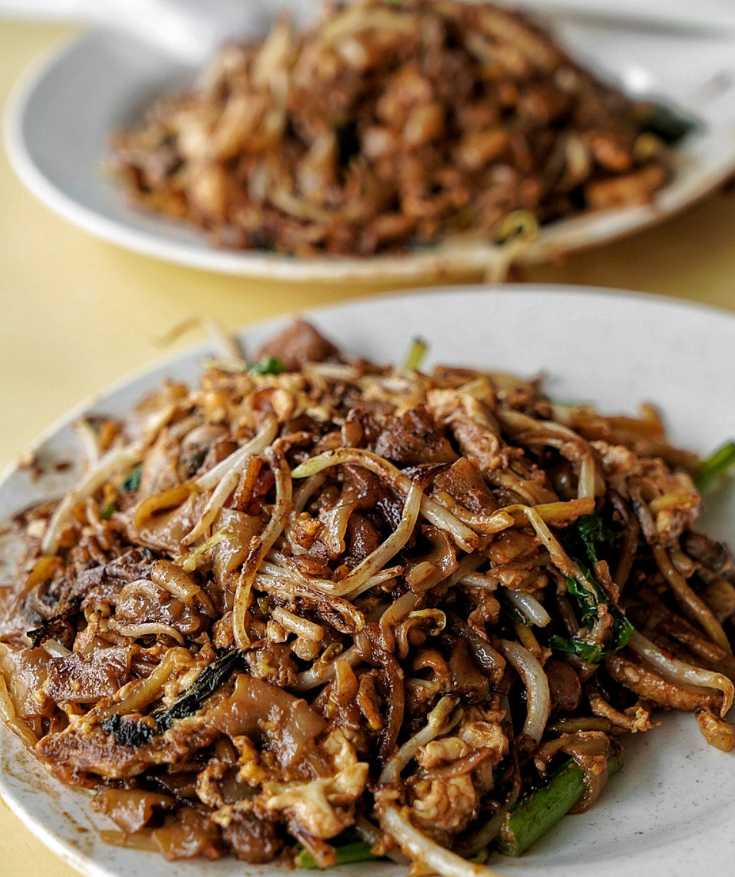

Chinese dock workers created this cost-effective, filling meal; its evolution is a testament to the city’s rapid modernization.
📍 Where to eat Char Kway Teow in Singapore: Cockle Fried Kway Teow and Seah Im Fried Kway Teow Mee
4. Ice Kacang
A vibrant pile of shaved ice, doused in colorful syrups, beans, and jellies, Ice Kacang is an aesthetic and sensory delight. It’s a chilled dessert, layering sweetness, and crunch in harmonious measures.
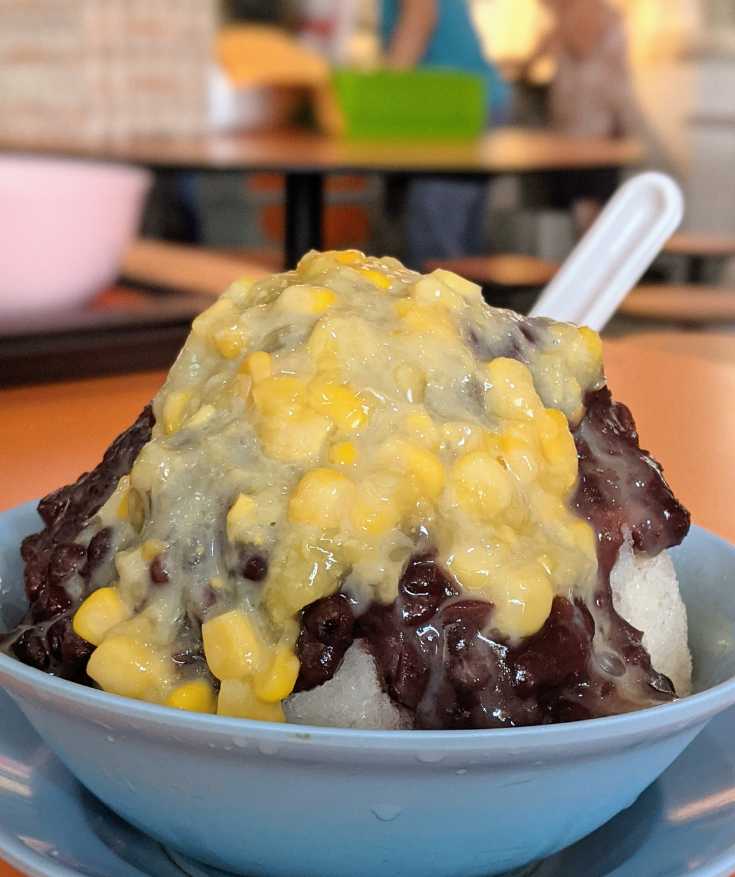

Originating from the ubiquitous ice ball peddled in the 1950s and 60s, Ice Kacang evolved with Singapore’s progression.
This dessert tells of the island’s multi-ethnic tapestry, where shared experiences crafted culinary wonders.
📍 Where to eat Ice Kacang in Singapore: Lit Lit Xin Cold and Hot Dessert
5. Fishball Noodles
Supple fish orbs paired with noodles, Fishball Noodles is a dish of delicate flavors and satisfying textures. Be it in soup or dry form, it represents a perfect union of simplicity and taste.
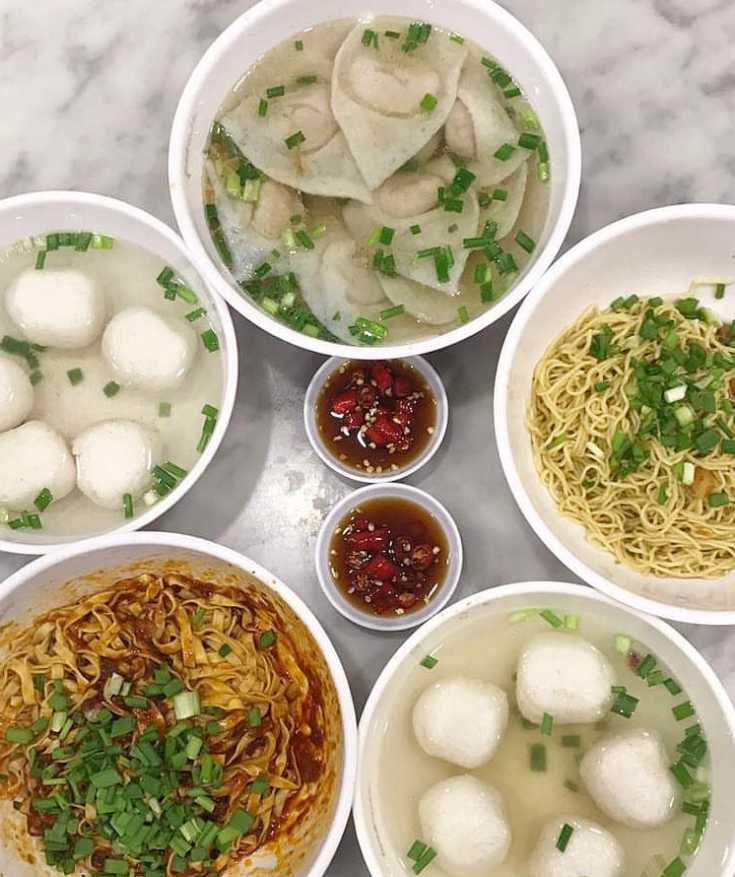

A nod to the Fujian Chinese settlers, this dish is an ode to Singapore’s hawker culture. Crafted for affordability and taste, it reflects the spirit of innovation amidst scarcity in the bygone era.
📍 Where to eat Fishball Noodles in Singapore: Li Xin Teochew Fishball Noodles and Song Kee Fishball Noodle
6. Otah-Otah
Aromatic fish paste, infused with spices and then steamed or grilled within banana leaves, Otah-Otah serves flavors that hit every note. Each bite is a spicy, fragrant revelation.
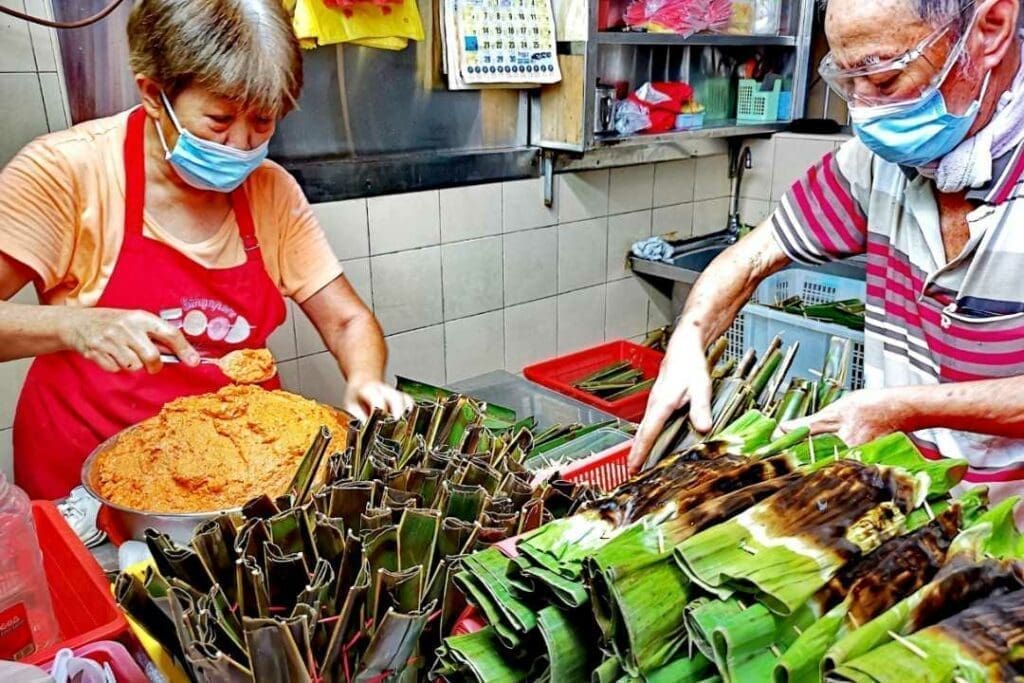

Hailing from the Malay Peninsula, Otah-Otah is Singapore’s culinary salute to shared Malay roots.
As migrants brought this dish to the island, it seamlessly melded into the local fare, echoing shared histories.
📍 Where to eat Otah Otah in Singapore: Hougang Otah and Tan Beng Otah Delights
7. Durian Pengat
A decadent durian-infused concoction, Durian Pengat tantalizes with its creamy, sweet, and slightly bitter profile. It’s an acquired delight made from the ‘king of fruits’.
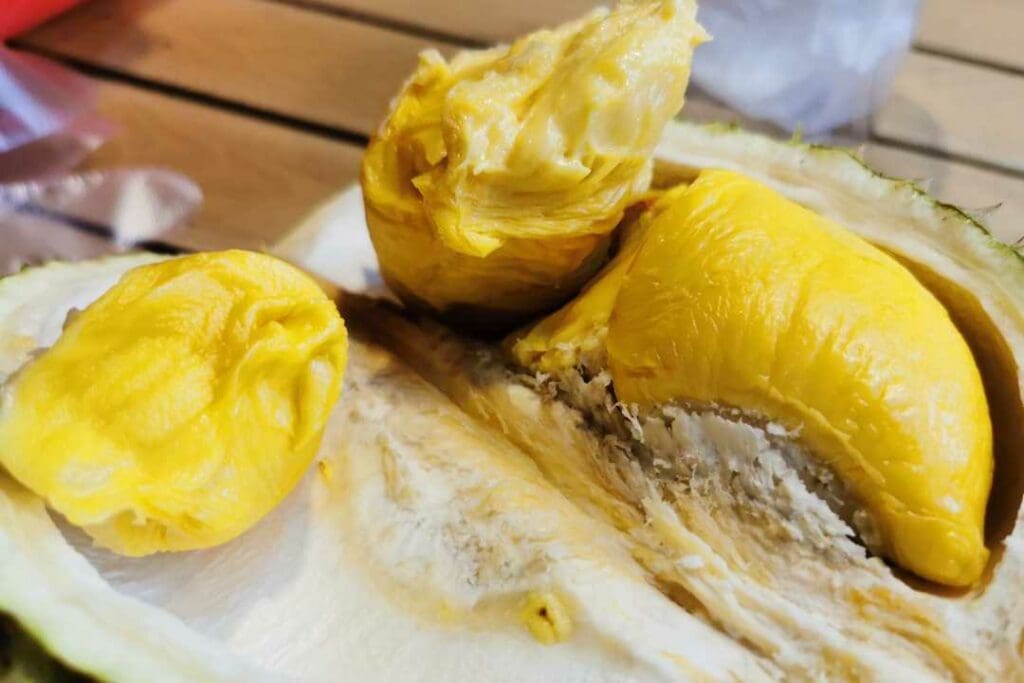

The indigenous tribes of Borneo and Sumatra first savored durian. As trade and migration flowed, Singapore embraced this polarizing fruit, culminating in delectable creations like Durian Pengat.
📍 Where to eat Durian Pengat in Singapore: Sinpopo Brand and J65
8. Mee Rebus
Mee Rebus cocoons yellow noodles within a thick, spicy-sweet gravy. Topped with lime, green chilies, and other condiments, it’s a dish that commands a palate dance.
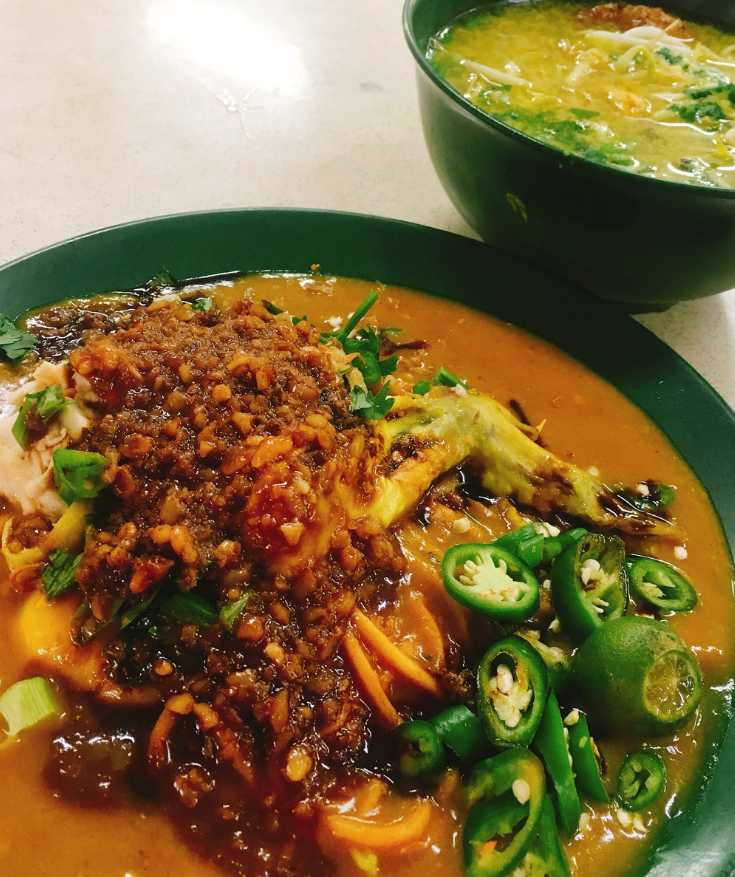

With Javanese origins, Mee Rebus showcases the maritime connections between Java and Singapore. Over time, local adaptations emerged, creating a distinctively Singaporean version.
📍 Where to eat Mee Rebus in Singapore: Afandi Hawa & Family Mee Rebus
9. Prawn Noodles
Prawn Noodles is a soul-warming broth teeming with prawns and noodles, a testament to Singapore’s love for seafood-based dishes. Its rich, umami-packed flavors are irresistibly inviting.
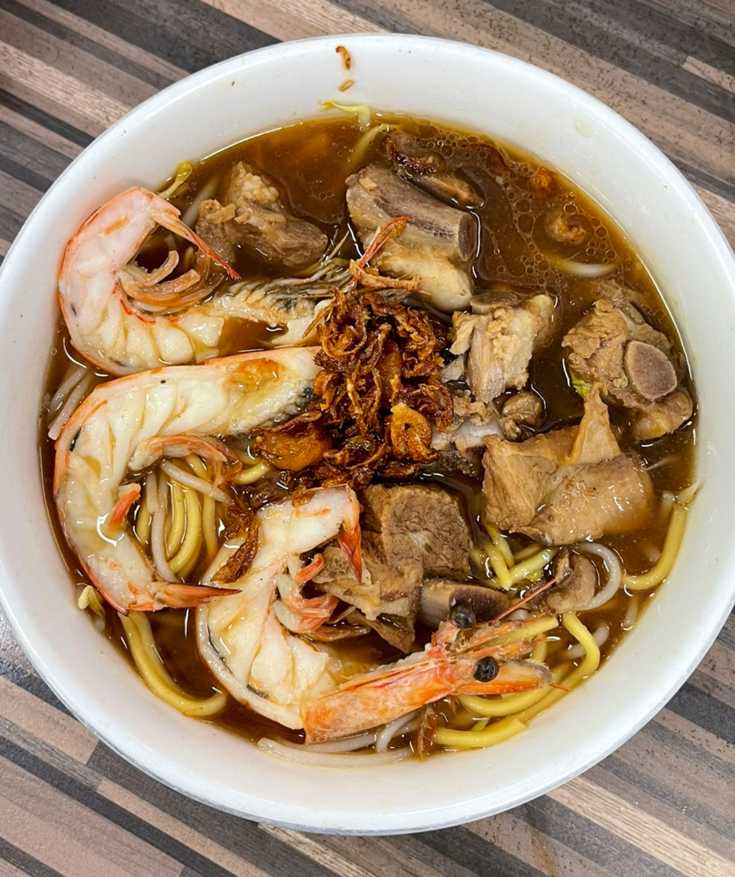

Tracing back to Chinese culinary traditions, especially the Hokkien region, Prawn Noodles celebrates Singapore’s position as a maritime nexus, interweaving influences from diverse seafaring traders.
📍 Where to eat Mee Rebus in Singapore: Zion Road Big Prawn Noodle and Beach Road Prawn Mee Eating House
10. Teh Tarik
More than just tea, Teh Tarik is a frothy spectacle. Black tea and condensed milk are “pulled” to perfection, resulting in a rich, sweet beverage with comfort and culture in a cup.
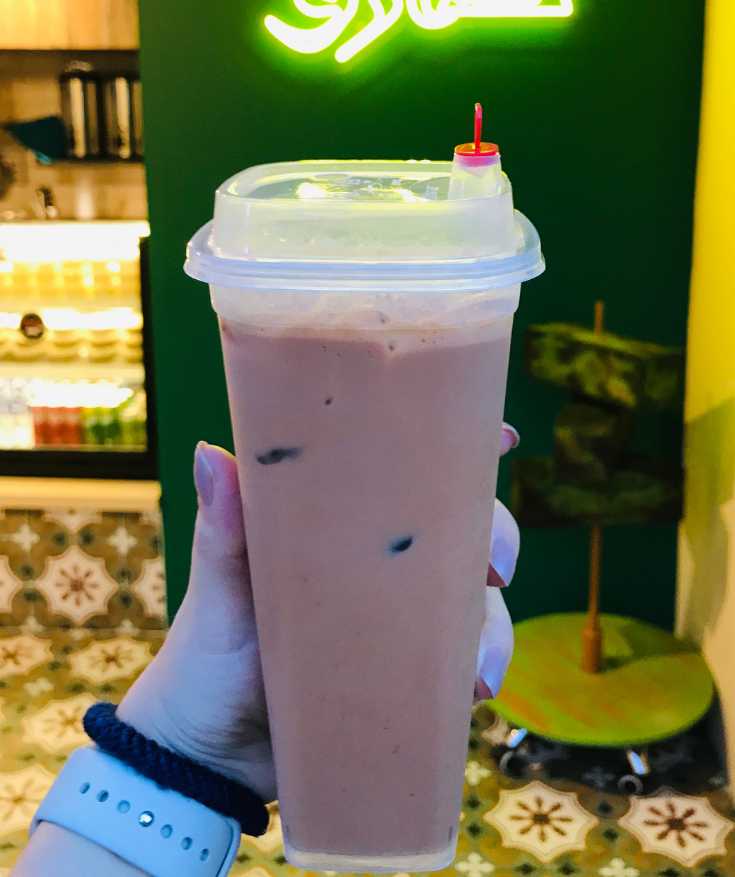

Indian-Muslim immigrants introduced this gem to Singapore. Over time, the art of ‘pulling’ tea became not just a technique but an integral part of Singapore’s vibrant hawker center tapestry.
📍 Where to get Teh Tarik in Singapore: Tarik Cafe at Kampong Glam
11. Mee Siam
A tangle of thin rice vermicelli served with a tangy, spicy broth, Mee Siam — which translates to “Siamese Noodle” — is an explosion of flavors, typically accompanied by prawns, egg, and tau pok (tofu puffs).
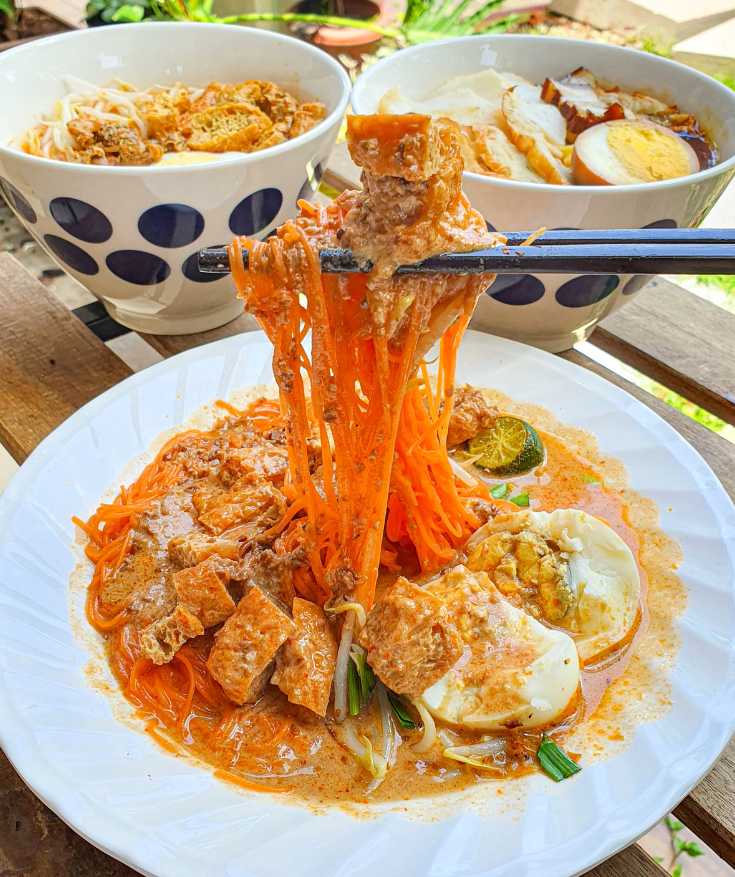

With a name suggesting Thai origins, Mee Siam has roots in the Malay and Peranakan kitchens. Over decades, it became a unique Singapore food, showcasing the nation’s culinary adaptability.
📍 Where to eat Mee Siam in Singapore: Hup Hup and Jia Xiang Mee Siam
12. Nasi Goreng
Directly translating to “fried rice”, Nasi Goreng is a hearty dish, tossed with spices, meat, and vegetables. Often crowned with a fried egg, it’s a flavorful mosaic of textures and tastes.
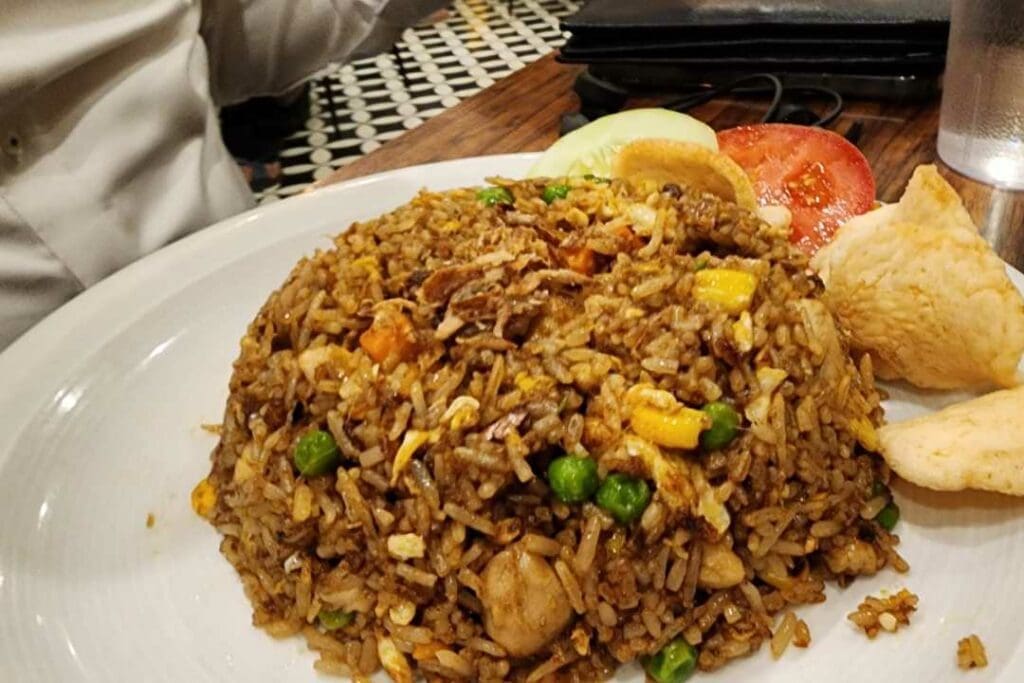

While Indonesian in origin, Nasi Goreng was embraced and adapted by diverse communities in Singapore, making it a favorite in the tapestry of local multicultural cuisine.
📍 Where to eat Nasi Goreng in Singapore: Indo Express and Minang House
13. Tau Huay (Soybean Curd)
A soft, silken tofu dessert, Tau Huay is delicately sweet, often swimming in a light syrup. Its melt-in-mouth texture is a delightful experience.
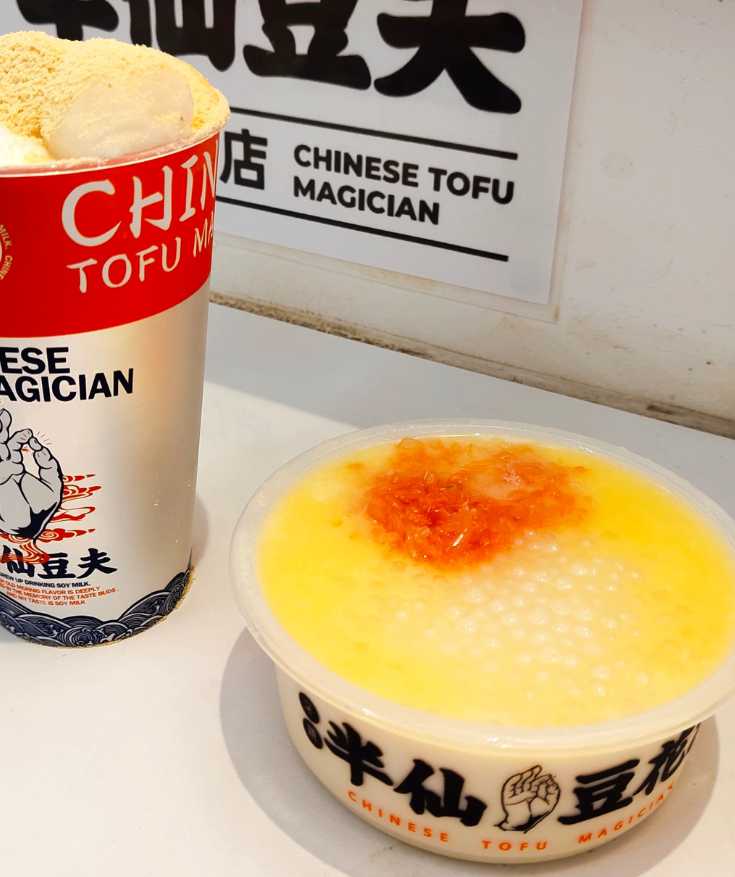

Introduced by Chinese immigrants, this humble soybean dish represents the simplicity and comfort of traditional Chinese desserts, having found a warm home amidst Singapore’s hawker stalls.
📍 Where to eat Tau Huay (Soybean Curd) in Singapore: Chinese Tofu Magician and Teck Seng Soya Bean Milk
14. Biryani
A fragrant rice dish, Biryani is adorned with spices, meat (often chicken or mutton), and sometimes boiled eggs. Each grain carries tales of aromatic indulgence.
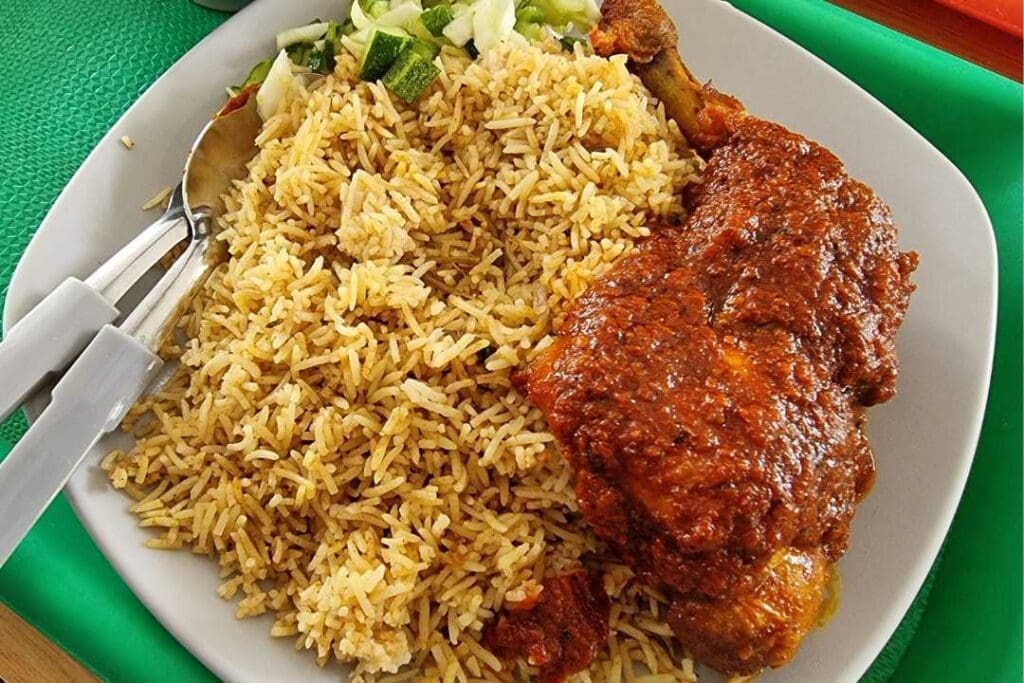

With its roots in South Asia, Biryani journeyed to Singapore with Indian immigrants. Over time, it intertwined with local flavors, giving birth to unmistakably Singaporean variations.
📍 Where to eat Biryani in Singapore: Bismi Biryani
15. Hainanese Chicken Rice
Poached chicken and seasoned rice, Hainanese Chicken Rice is a deceptively simple dish. Paired with chili and ginger paste, it’s a symphony of subtle flavors.
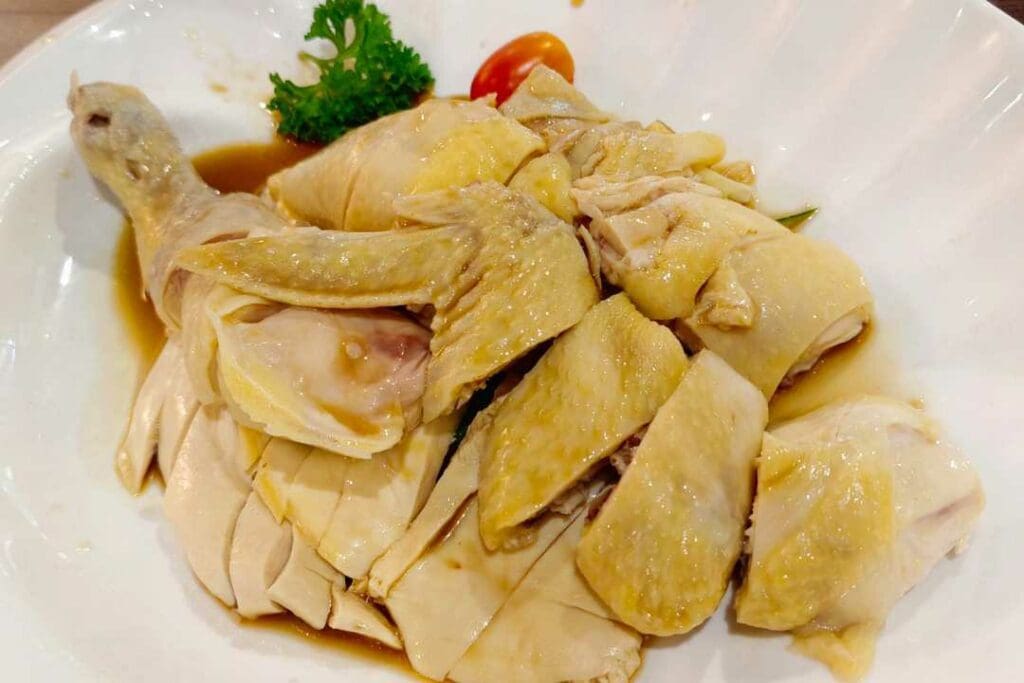

Brought by Chinese migrants from Hainan province, this dish underwent a local evolution. What started as a modest meal in the immigrant community is now a national icon.
📍 Where to eat Hainanese Chicken Rice in Singapore: Boon Tong Kee and Five Star Chicken Rice
16. Bak Kut Teh
Translating to “Meat Bone Tea”, Bak Kut Teh is a peppery or herbal pork rib soup. It’s a soul-soothing brew, often enjoyed with rice and dough fritters.
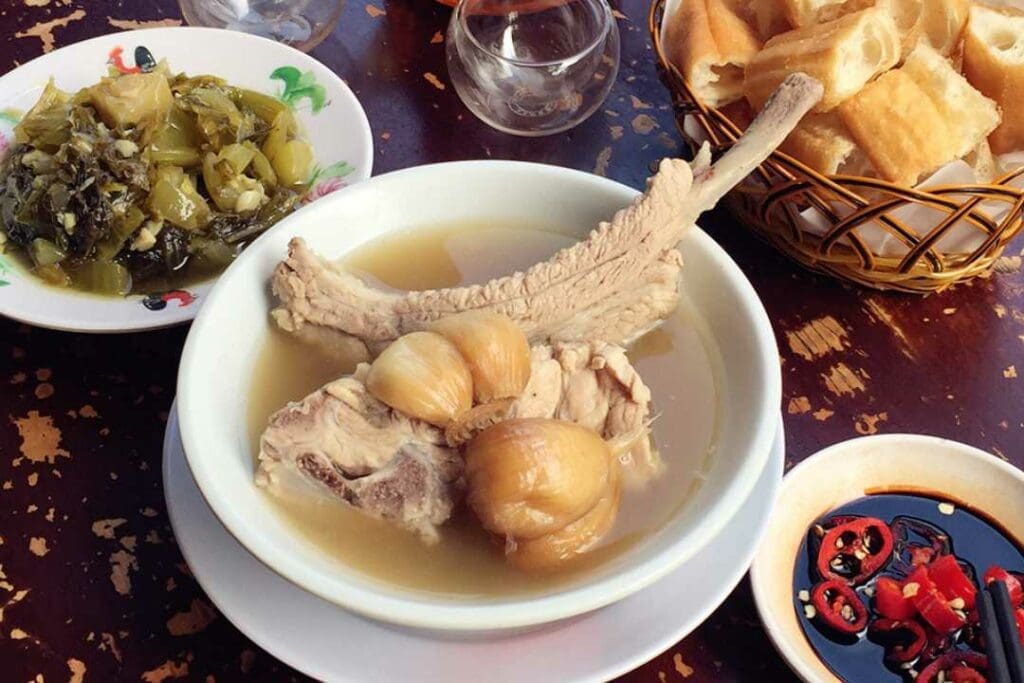

Conceived as a nourishing meal for Chinese laborers in old Singapore, Bak Kut Teh has transformed over the years, with variations reflecting the diverse Chinese dialect groups of the island.
📍 Where to eat Bak Kut Teh in Singapore: Outram Ya Hua Bak Kut Teh and Legendary Bak Kut Teh
17. Nasi Lemak
Coconut milk-infused rice, anchovies, peanuts, boiled egg, and fiery sambal form Nasi Lemak. This dish is a riot of flavors, beautifully packed in banana leaves.
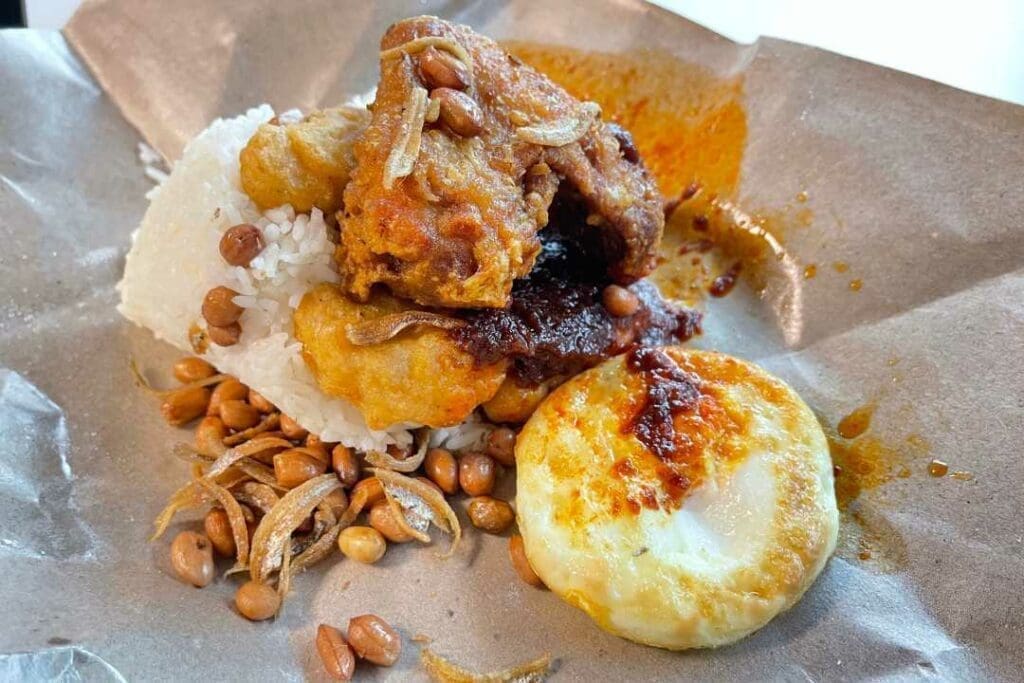

Nasi Lemak, originally a Malay farmer’s breakfast, symbolizes Singapore’s Malay roots. Today, its numerous renditions echo Singaporean kitchens’ harmonious blend of traditions and innovations.
📍 Where to eat Nasi Lemak in Singapore: Boon Lay Power Nasi Lemak
18. Bak Chor Mee
Minced meat noodles, Bak Chor Mee, when done right, showcases al dente noodles, savory minced meat, mushrooms, and a vinegary sauce — a gastronomic ballet of tastes.
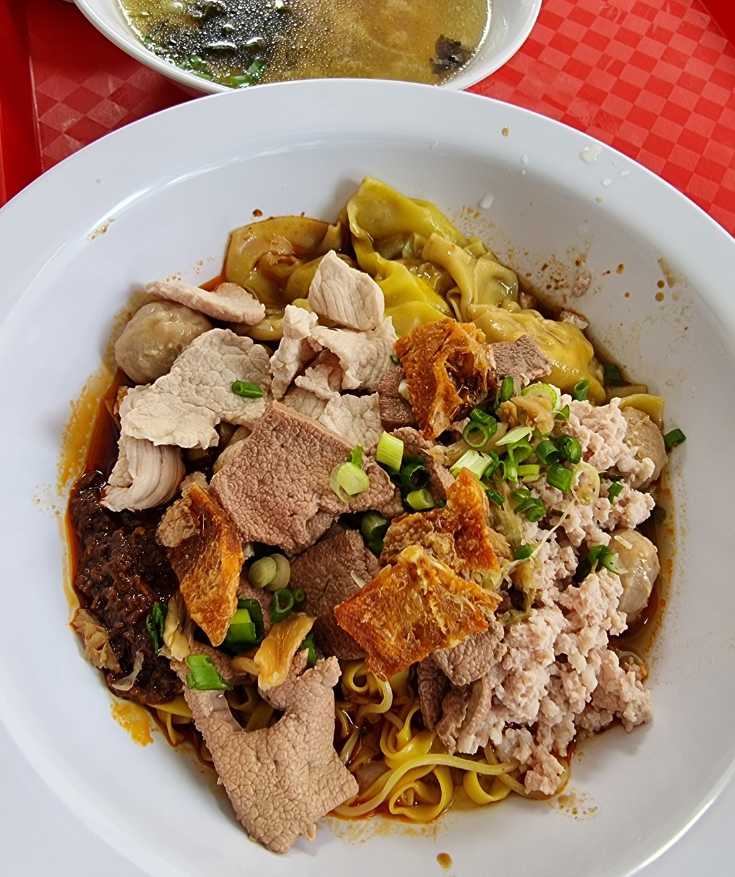

Rooted in the Teochew community of Singapore, this noodle dish transformed from humble street food into a culinary mainstay, narrating tales of migration and adaptation.
📍 Where to eat Bak Chor Mee in Singapore: Hill Street Tai Hwa Pork Noodle
19. Roti Prata
A crispy, flaky flatbread, Roti Prata is sheer indulgence. Best savored with curry, its buttery layers unravel with every bite.
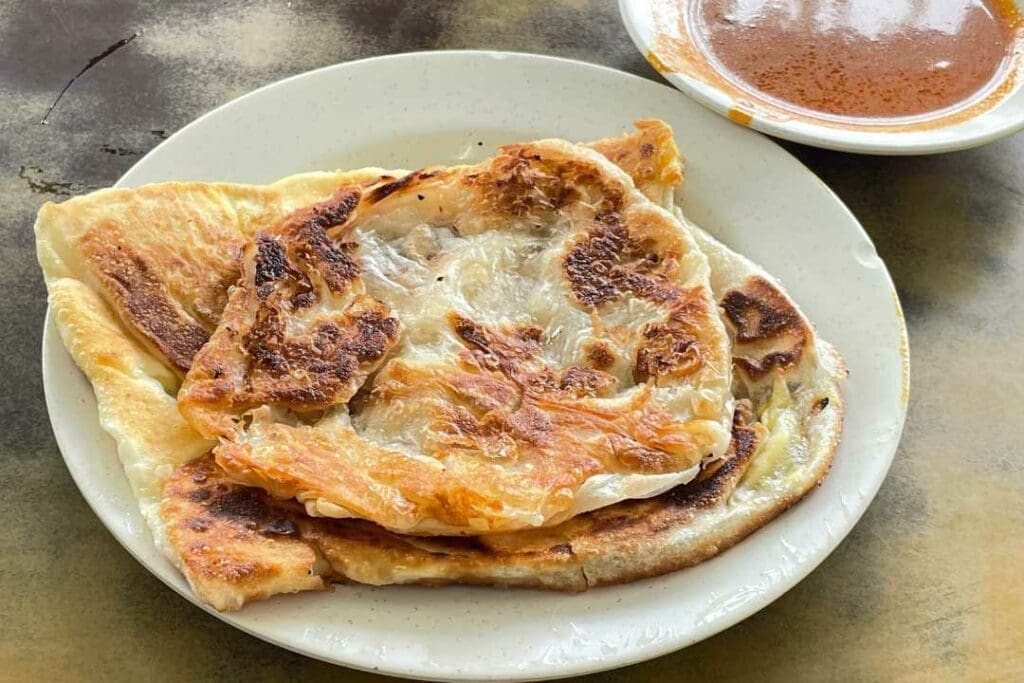

Traced back to the Indian subcontinent where it’s known as “paratha”, Roti Prata sailed to Singapore with Indian-Muslim immigrants.
Over time, local twists emerged, crafting a distinct Singaporean identity for this beloved bread.
📍 Where to eat Roti Prata in Singapore: Mr and Mrs Mohgan’s and Casuarina Curry
20. Rojak
A zesty salad of fruits, vegetables, and dough fritters, Rojak is doused in a pungent shrimp paste and sprinkled with crushed peanuts. It’s a dish as diverse as Singapore itself.
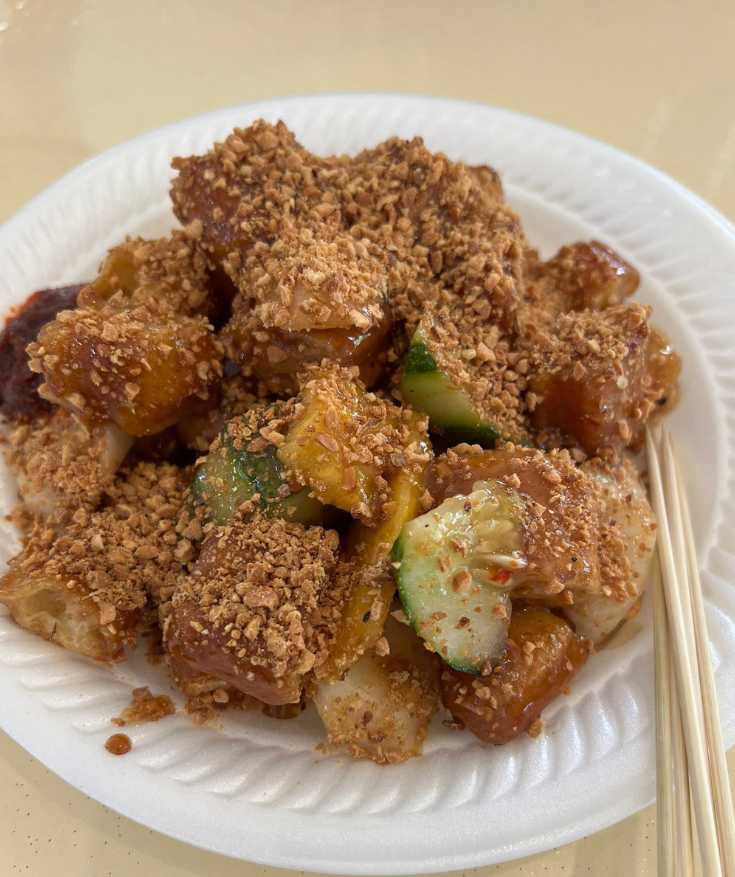

Reflecting Singapore’s multicultural fabric, Rojak combines Malay, Chinese, and Indian elements. It’s a metaphorical and literal mix, capturing the essence of the nation’s melting pot narrative.
📍 Where to eat Rojak in Singapore: 684 Black & White Rojak and Lau Hong Ser
21. Chai Tow Kway (Carrot Cake)
A misnomer to Western ears, Singapore’s Carrot Cake involves no carrots. It’s a savory treat of radish cake cubes stir-fried with garlic, eggs, and preserved radish.
It’s a delightful bite whether in its black (with sweet sauce) or white version.
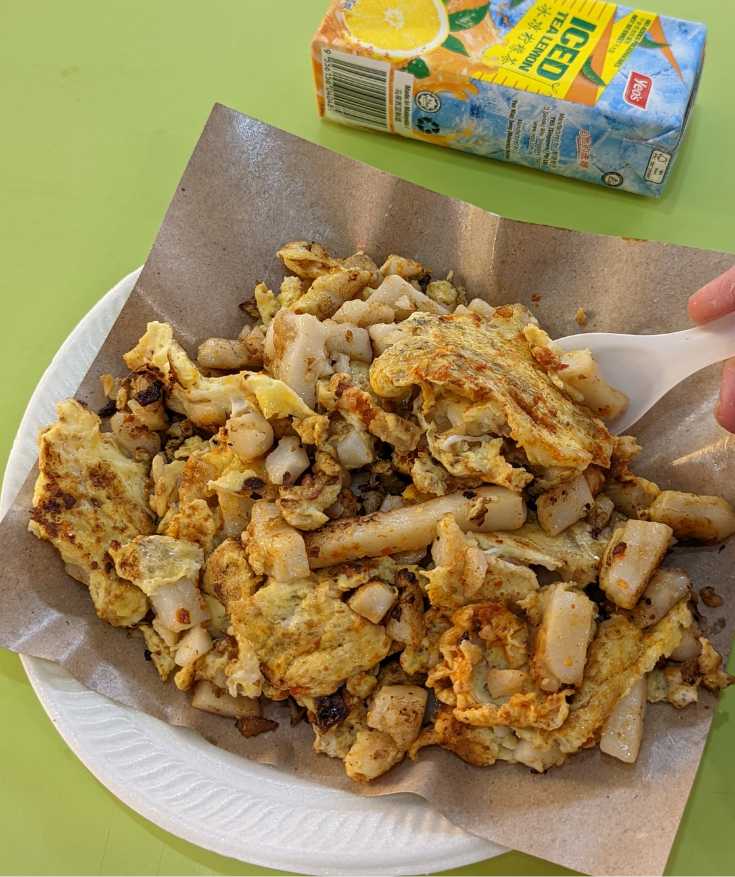

Rooted in Teochew and Hokkien communities, Chai Tow Kway showcases how Singapore adapted traditional recipes, creating an entirely unique dish that’s now a breakfast favorite.
📍 Where to eat Chai Tow Kway in Singapore: Guan Kee Fried Carrot Cake and 89 Carrot Cake (#01-102)
22. Kaya Toast
A simple yet indulgent breakfast item, Kaya Toast features slices of toasted bread slathered in kaya (coconut and egg jam) and butter. It’s sweet, creamy, and slightly crispy.
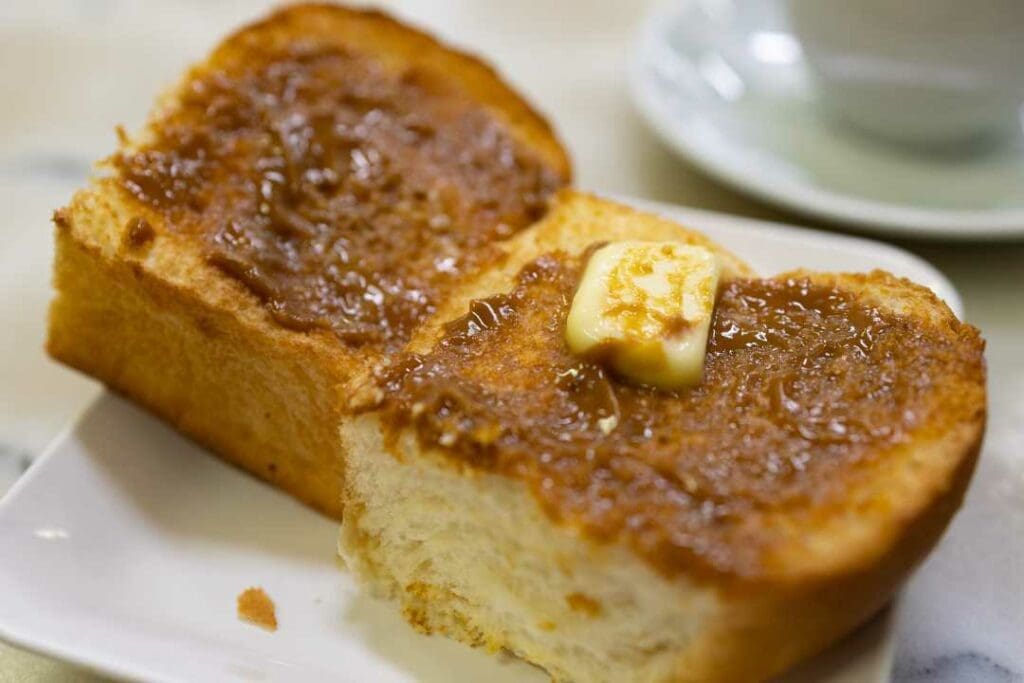

As Singapore modernized, Western influences melded with local flavors. The resultant Kaya Toast epitomizes East meets West — a colonial legacy with a distinct Peranakan touch in the kaya.
📍 Where to eat Kaya Toast in Singapore: Man Lai Kopi and YY Kafei Dian
23. Satay
Skewered and grilled meat, Satay drips in flavor, typically served with peanut sauce, rice cakes, and a small serving of a pickled side. It’s a tantalizing treat, perfumed with smoky goodness.
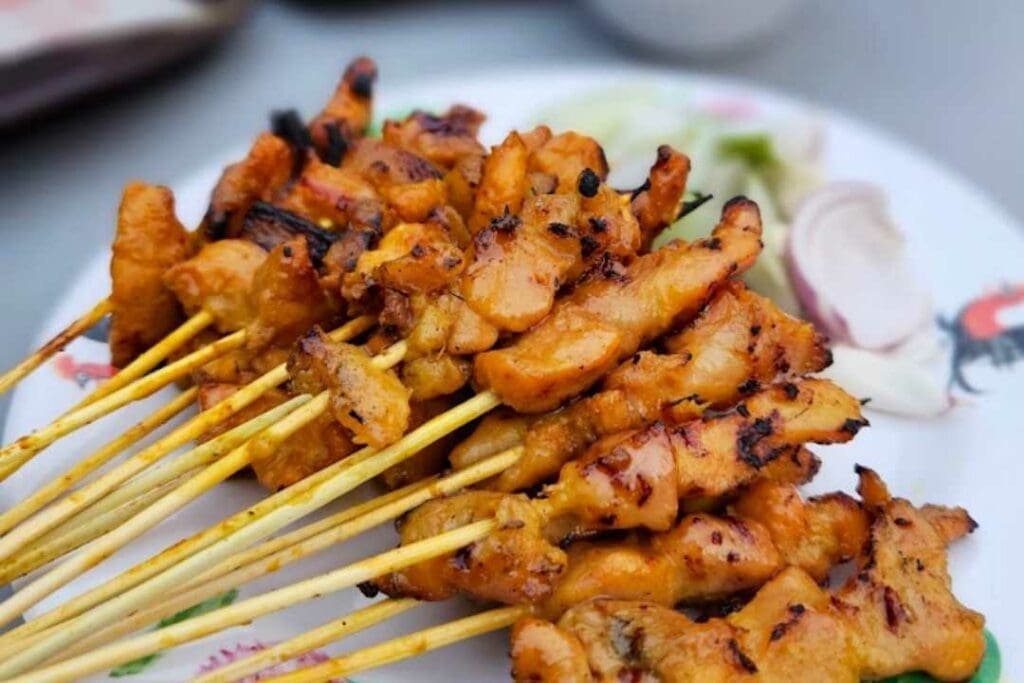

A dish with Malay and Indonesian ancestry, Satay is a testament to Singapore’s position as a cultural crossroads. Adapted over time, the local version is a beloved fixture in food markets.
📍 Where to eat Satay in Singapore: Lau Pa Sat Satay and Chomp Chomp Satay
24. Hokkien Mee
A stir-fried noodle dish, Hokkien Mee combines prawns, squid, and a rich stock, presenting a luscious, fragrant offering that satiates and delights.
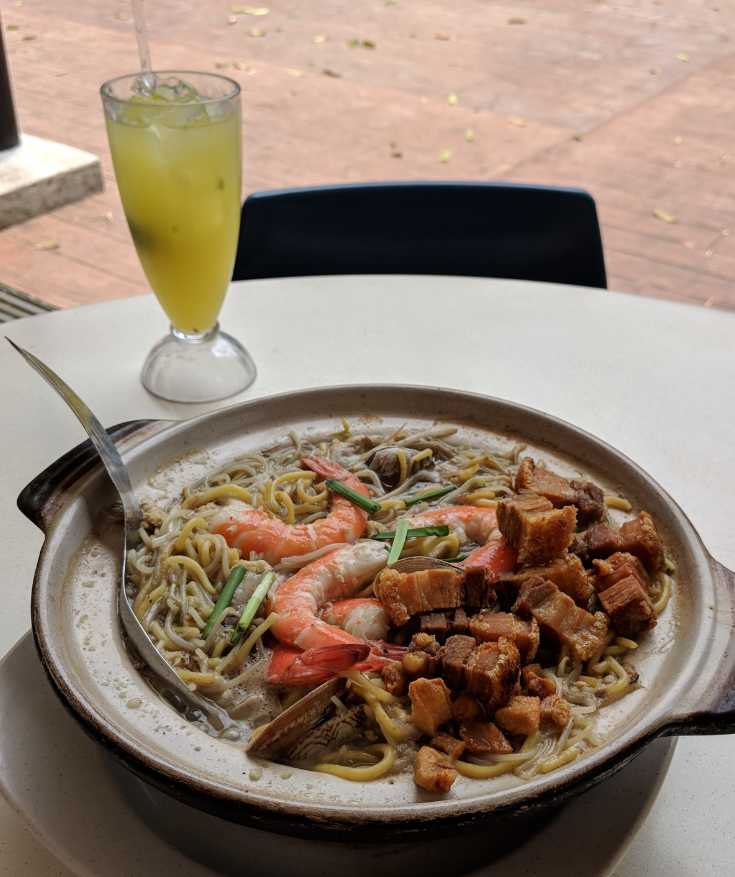

Birthed post-World War II by Chinese Hokkien immigrants, Hokkien Mee encapsulates Singapore’s resilience and adaptability, transforming available ingredients into a now iconic dish.
📍 Where to eat Hokkien Mee in Singapore: Kim Keat Hokkien Mee and Come Daily Hokkien Mee
25. Beef Rendang
Slow-cooked to perfection, Beef Rendang is a dry curry deeply spiced and enriched with coconut milk. The meat is tender, and the flavors are profound.
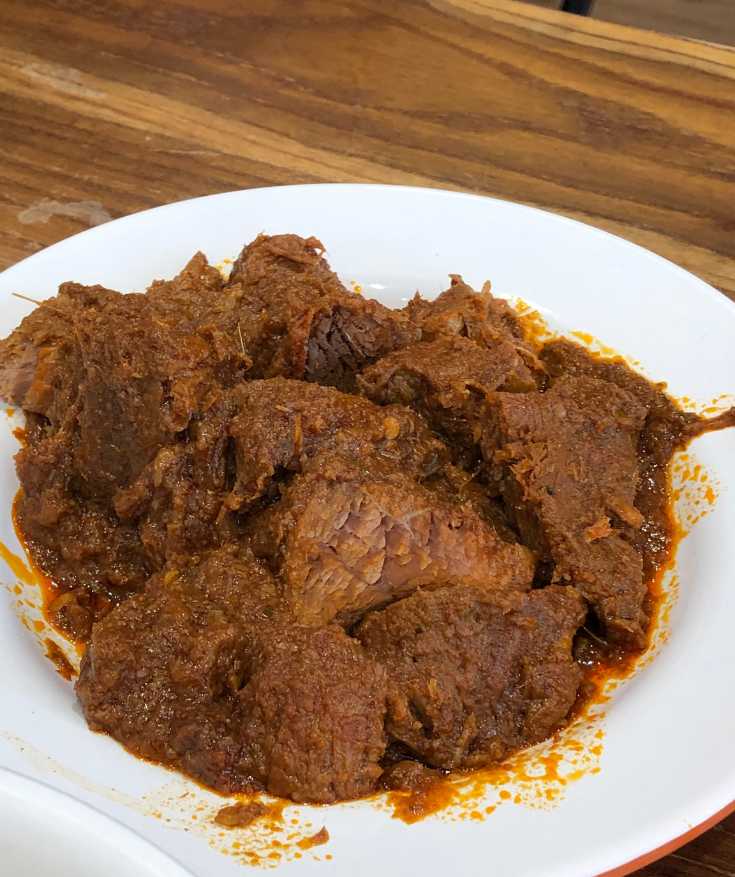

Rendang, of Minangkabau origins in Indonesia, journeyed to Singapore with Malay settlers. Its presence today stands as a homage to shared culinary legacies and communal festivities.
📍 Where to eat Beef Rendang in Singapore: HJH Maimunah and Rumah Makan Minang
26. Fish Head Curry
A spicy, tangy curry where the fish’s head is the star. Bold flavors of tamarind and various spices create a symphony, making it a sought-after delicacy.
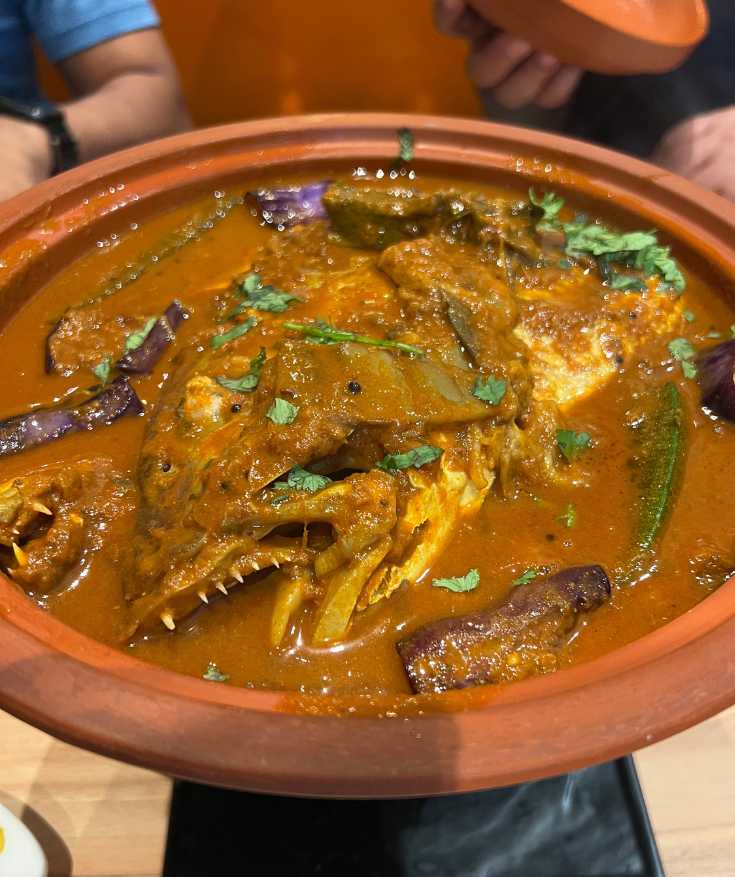

Conceived in the kitchens of Singapore’s Indian community, Fish Head Curry is a harmonious fusion of Indian spices and Chinese preferences for fish head, exemplifying Singapore’s multicultural culinary landscape.
📍 Where to eat Fish Head Curry in Singapore: Na Na Curry and Pavilion Banana Leaf
27. Popiah
A fresh spring roll, Popiah is filled with a medley of cooked vegetables, shrimp, and sometimes meat. Its soft, thin crepe contrasts delightfully with the hearty filling.
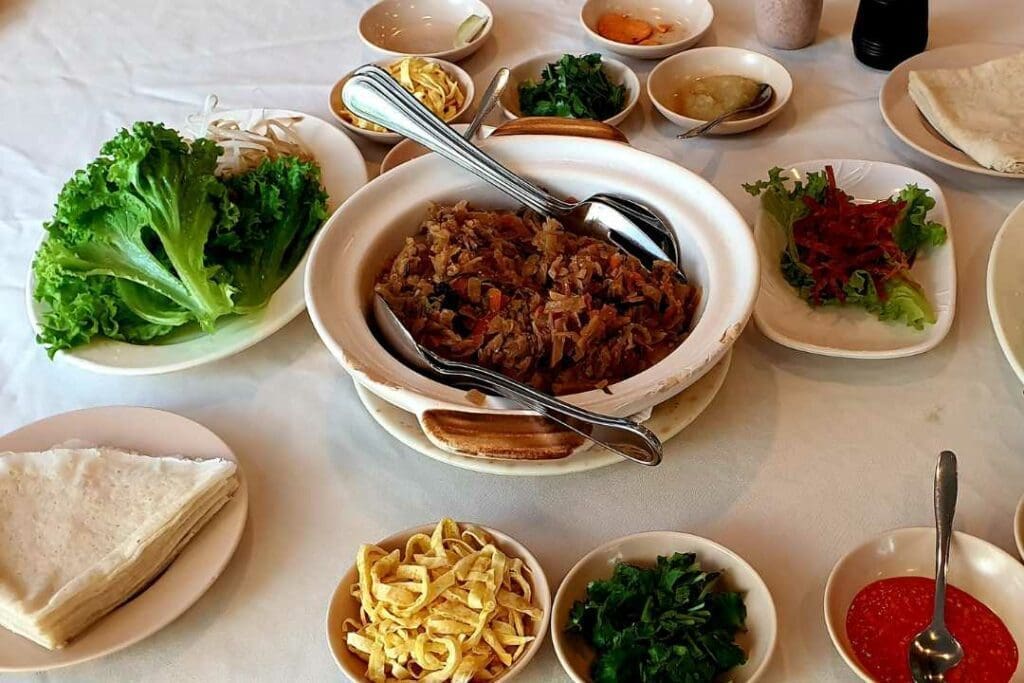

With Fujian roots, Popiah sailed to Singapore’s shores with Chinese immigrants. Over time, it’s been embraced and adapted by various communities, mirroring the nation’s inclusive spirit.
📍 Where to eat Popiah in Singapore: Good Chance Popiah Eating House and Ann Chin Popiah
28. Or Luak (Oyster Omelette)
A delightful blend of starch, eggs, and fresh oysters, Or Luak is crispy on the edges and soft in the center. A zesty chili dip usually complements its briny, rich flavors.
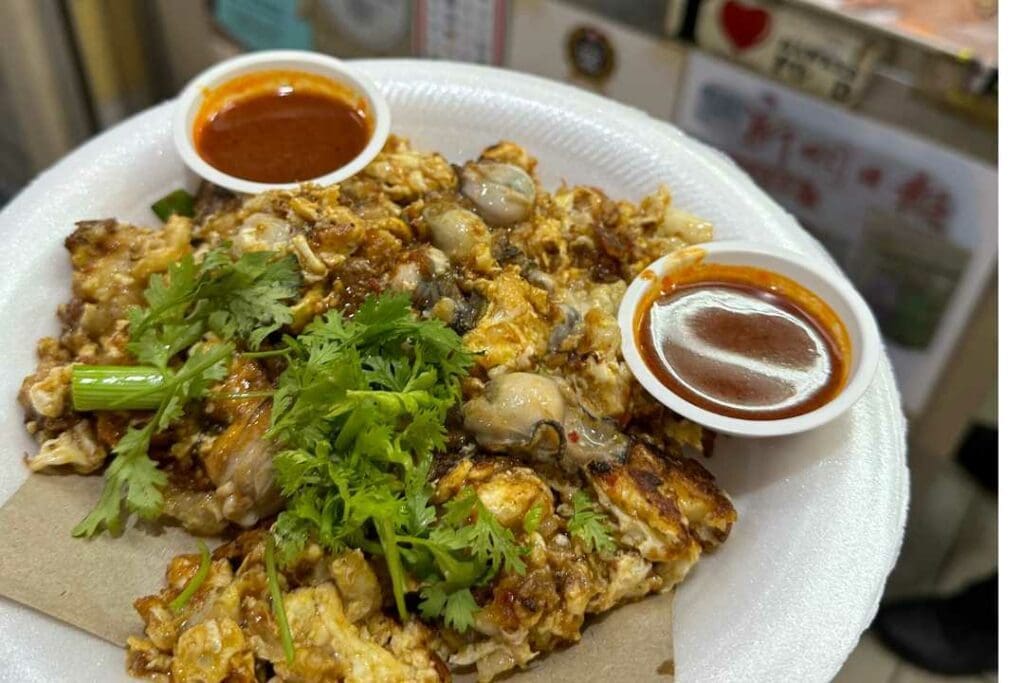

An import from Taiwan’s night markets, the oyster omelette quickly found favor in Singapore. Locals put their spin on it, reinforcing the nation’s reputation for culinary reinvention.
📍 Where to eat Or Luak (Oyster Omelette) in Singapore: Lim’s Fried Oysters and Ah Chuan Fried Oyster Omelette
29. Tandoori Chicken
A fiery red chicken, marinated in yogurt and spices, then cooked in a tandoor (clay oven). Tandoori Chicken is smoky, slightly charred, and utterly delectable.
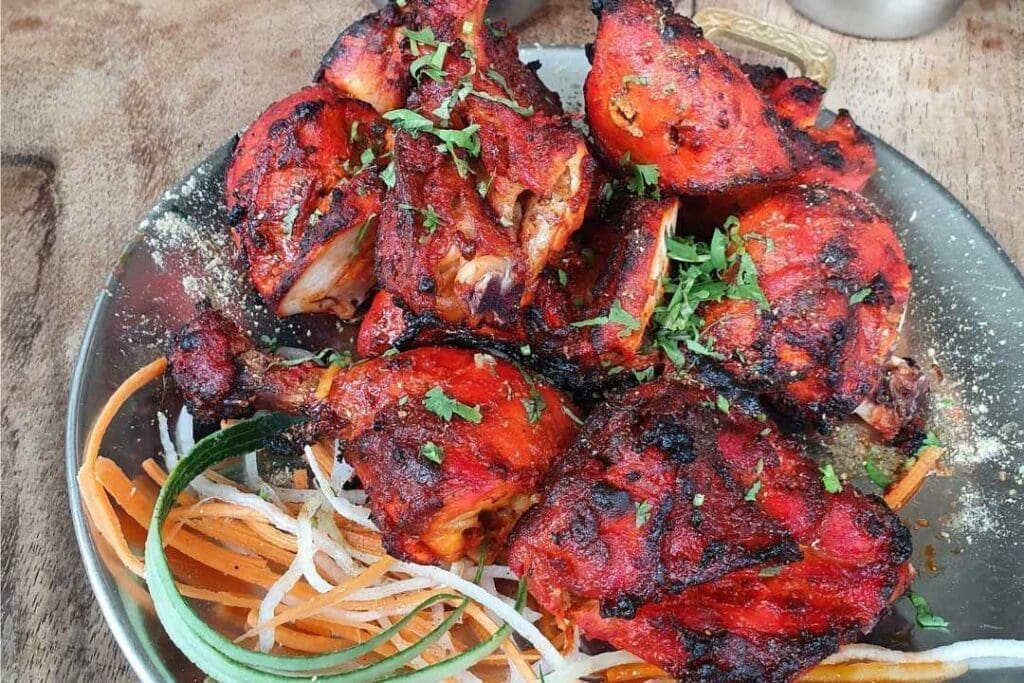

Brought by North Indian migrants, Tandoori Chicken is a flavorsome testament to Singapore’s Indian heritage. Its vivid presence in local eateries showcases the melding of traditions in Singaporean food culture.
📍 Where to eat Tandoori Chicken in Singapore: Khansama Tandoori Restaurant (Little India) and Daawat Tandoori
30. Duck Rice
Succulent braised duck served over rice, Duck Rice is often accompanied by herbal soup and spicy condiments. The tender meat and flavorful rice create a harmonious plate.
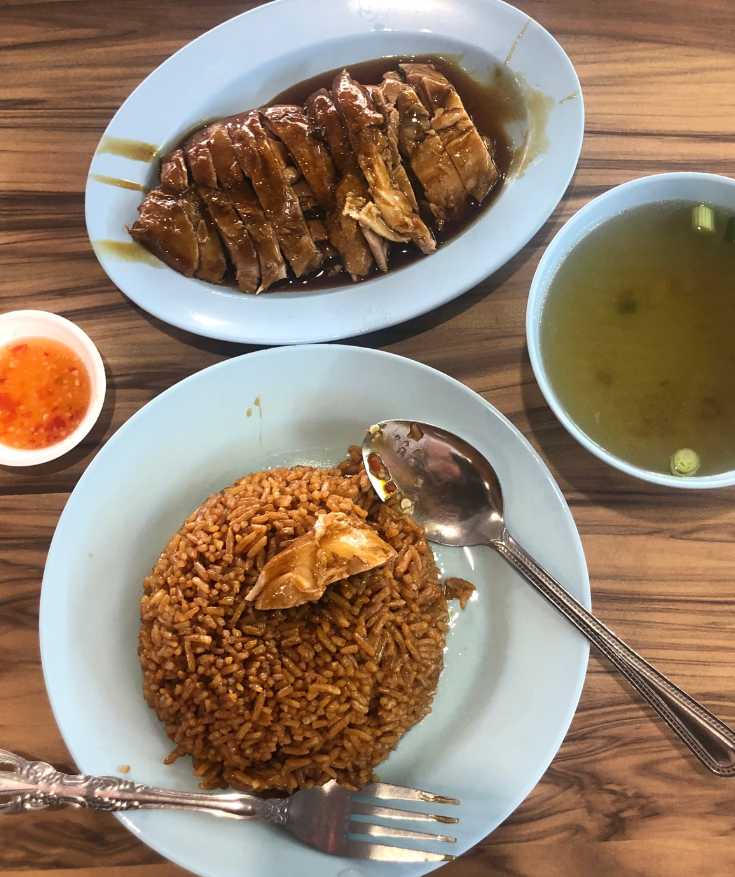

Duck Rice is a testament to the diaspora’s influence on Singapore’s rich gastronomic scene, tracing its lineage to the Teochew and Hokkien communities of China.
Adapted to local tastes, it’s now a Singapore food uniquely its own.
📍 Where to eat Duck Rice in Singapore: Ah Xiao Teochew Braised Duck and Cheok Kee Boneless Braised Duck
31. Yong Tau Foo
A versatile dish, Yong Tau Foo features an assortment of tofu and vegetables, often stuffed with fish paste, then boiled in a light broth.
The choices for customization are vast, from bitter gourd to chili, and it can be enjoyed with rice or noodles.
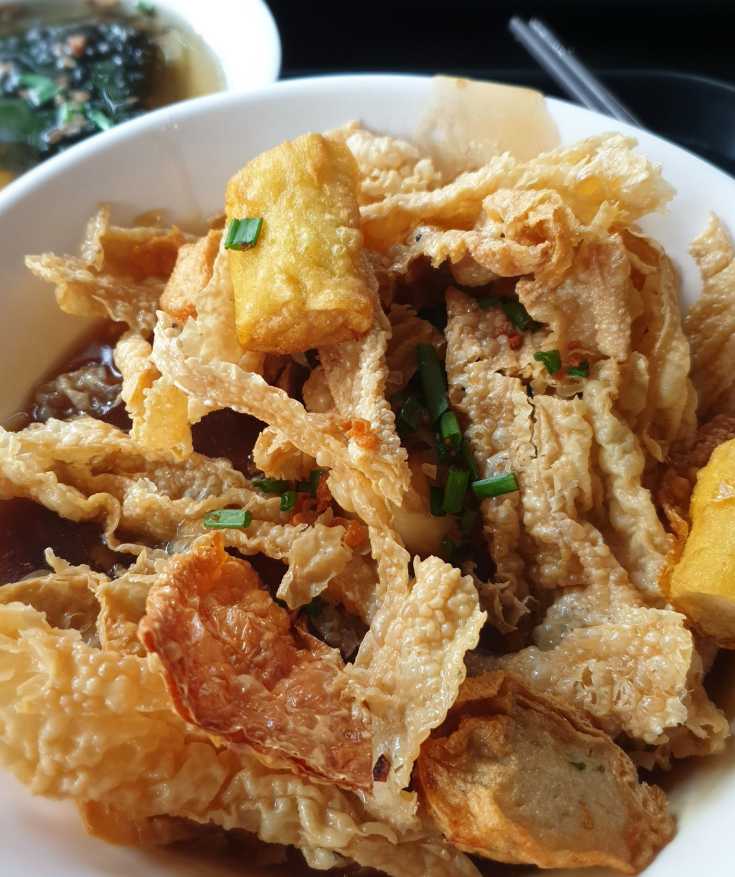

With Hakka origins, Yong Tau Foo evolved in Singapore. Initially, it consisted mainly of tofu, but it expanded to include a variety of ingredients, exemplifying Singapore’s penchant for culinary innovation.
📍 Where to eat Yong Tau Foo in Singapore: 109 Yong Tau Foo and Fu Lin Tofu Yuen
32. Sambal Stingray
Grilled stingray slathered with a spicy sambal (chili paste), this dish is a perfect combination of smokiness and spice, often served on banana leaves for that added aromatic touch.
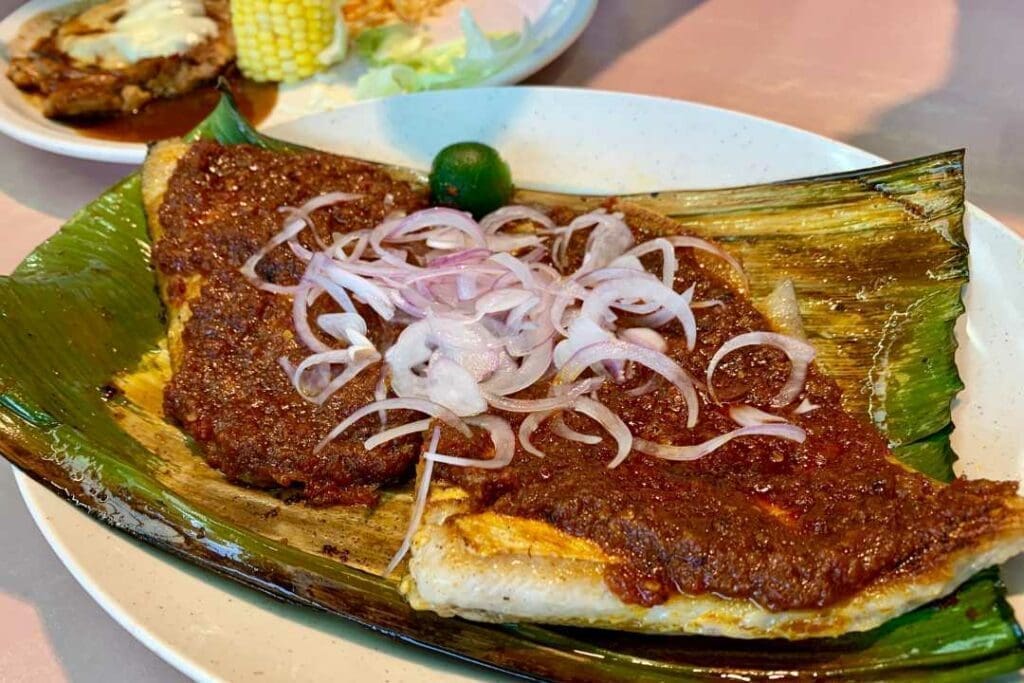

While stingray has been part of the region’s diet for ages, the genius of pairing it with sambal is a uniquely Singaporean-Malay innovation, reflecting the island’s love for all things spicy.
📍 Where to eat Sambal Stingray in Singapore: Star Yong Kwang Seafood and Chan BBQ
33. Curry Puff
A deep-fried or baked pastry pocket, Curry Puff encases a savory filling of curried potatoes, meat, and sometimes egg. Its flaky exterior contrasts beautifully with the soft, spiced interior.
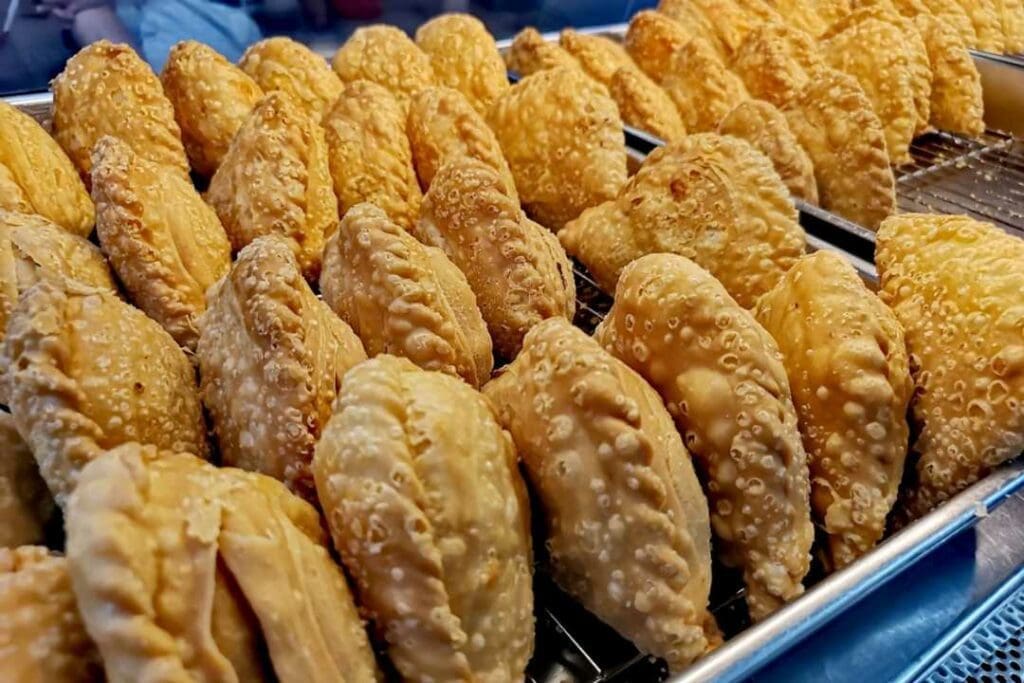

Likely influenced by the samosas of India, the Curry Puff evolved with the infusion of local flavors, resulting in a snack that’s quintessentially Southeast Asian.
📍 Where to eat Curry Puff in Singapore: Tanglin Crispy Curry Puff
34. Kueh Pie Tee
Resembling small hats, Kueh Pie Tee is a thin, crispy pastry shell filled with a mix of thinly sliced vegetables and prawns. It’s an elegant bite-sized delight.
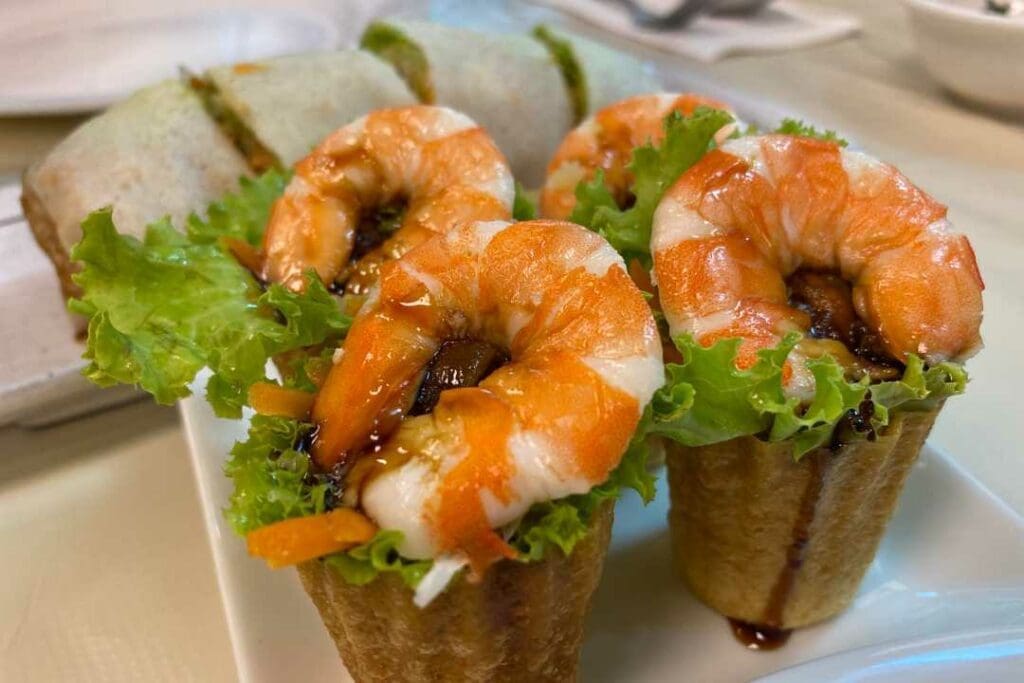

Born from the Peranakan community, this dish blends Chinese ingredients with Malay techniques, symbolizing the rich cross-cultural heritage of the Straits Chinese.
35. Laksa
A spicy noodle soup with a coconut milk or tamarind base, Laksa is adorned with shrimp, fish, or chicken. Its rich, fragrant broth is both comforting and invigorating.
With murky origins spanning the Malay Peninsula and Peranakan culture, Laksa has many regional varieties.
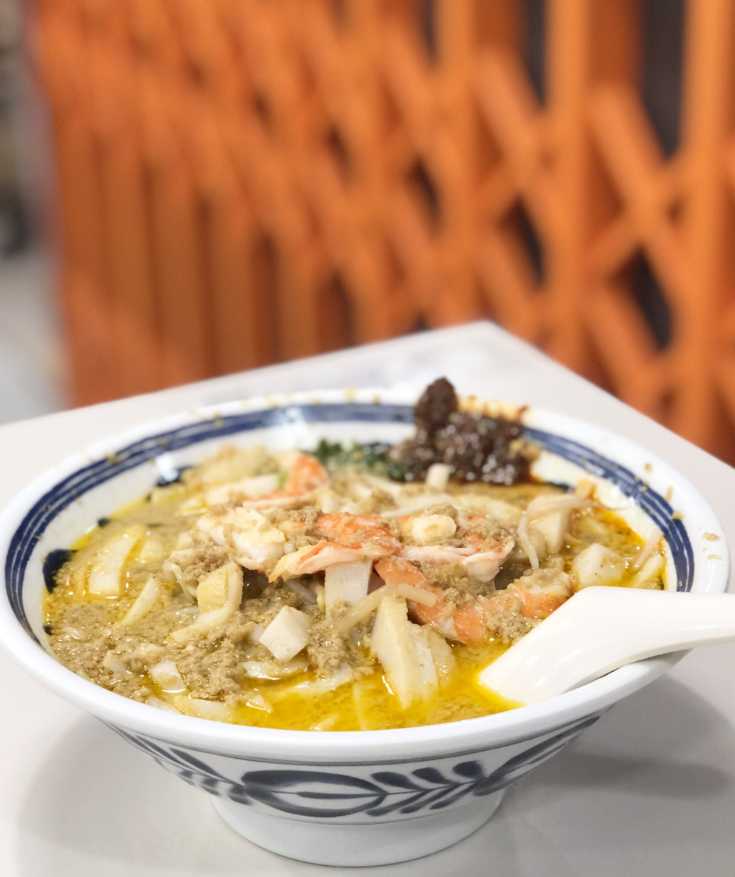

Singapore’s version, particularly the Katong Laksa, has gained legendary status, narrating stories of migrations and cultural intersections.
📍 Where to eat Laksa in Singapore: 328 Katong Laksa and Janggut Laksa
36. Tau Suan
Tau Suan is a sweet soup with split mung beans thickened into a starchy consistency, usually garnished with crisp dough fritters. It’s a warm, comforting dessert.
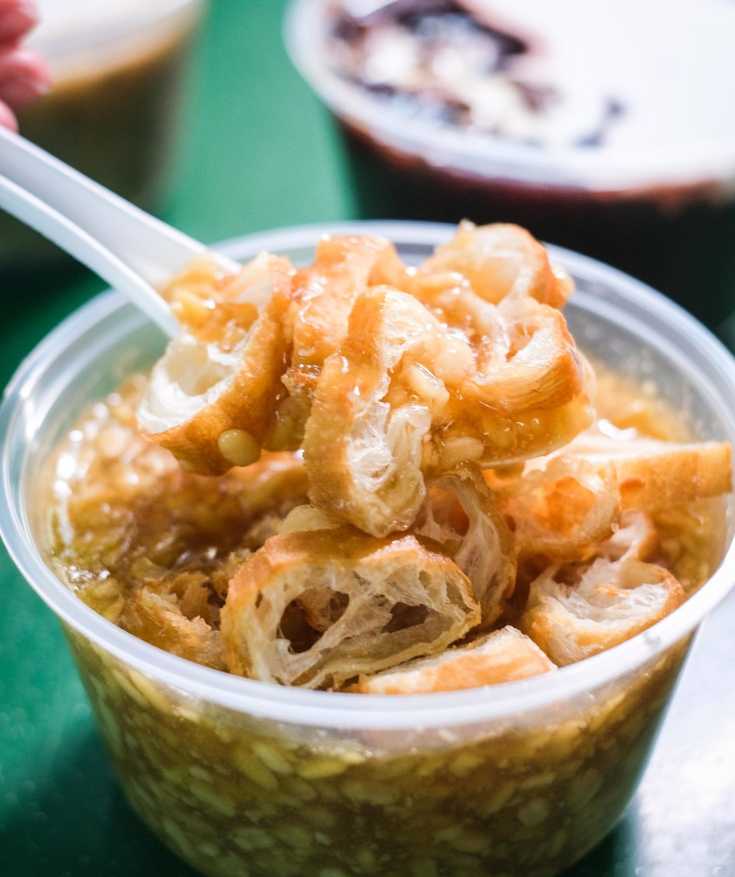

A dessert of Chinese origin, Tau Suan has found its way into the heart of Singapore’s diverse food tapestry, showcasing the nation’s embrace of various culinary traditions.
📍 Where to eat Tau Suan in Singapore: Zheng Xing Desserts and Tiong Bahru Tau Suan
37. Lor Mee
Thick, starchy gravy blankets yellow noodles in Lor Mee, with ingredients like braised pork, fish cake, and boiled egg. The dish offers a delightful interplay of textures.
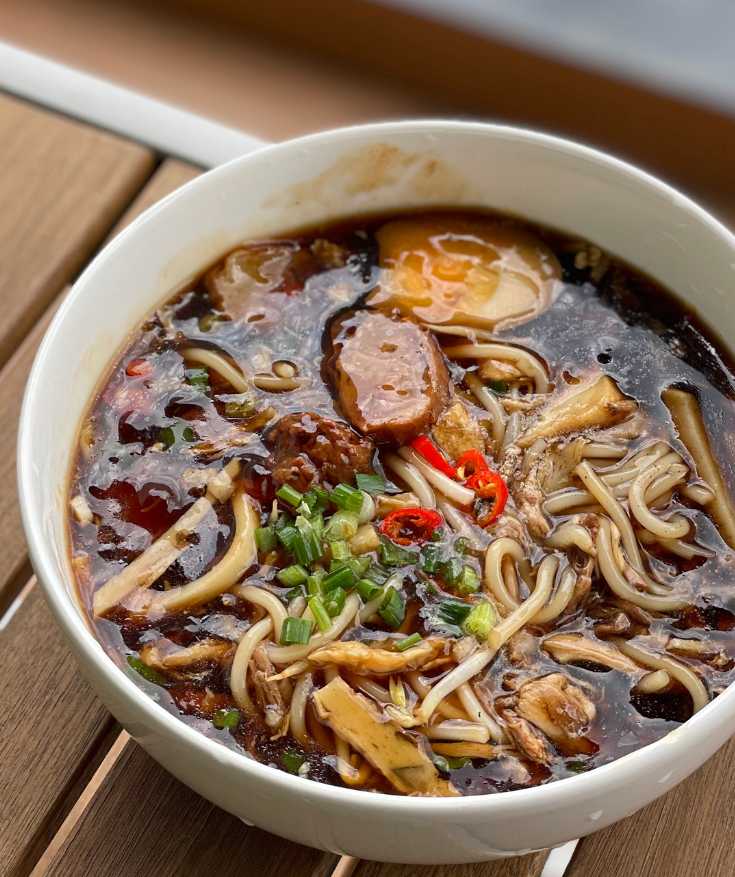

Introduced by Chinese immigrants, Lor Mee has been adopted and adapted over the years. Various iterations of this dish in Singapore’s hawker centers attest to its enduring appeal and evolution.
📍 Where to eat Lor Mee in Singapore: Lorong Ah Soo Lor Mee and Yew Tee Feng Zhen Lor Mee
38. Wanton Mee
Egg noodles paired with bite-sized dumplings (wantons) and often slices of char siu (barbecued pork), Wanton Mee can be served dry with a sauce or in a broth.
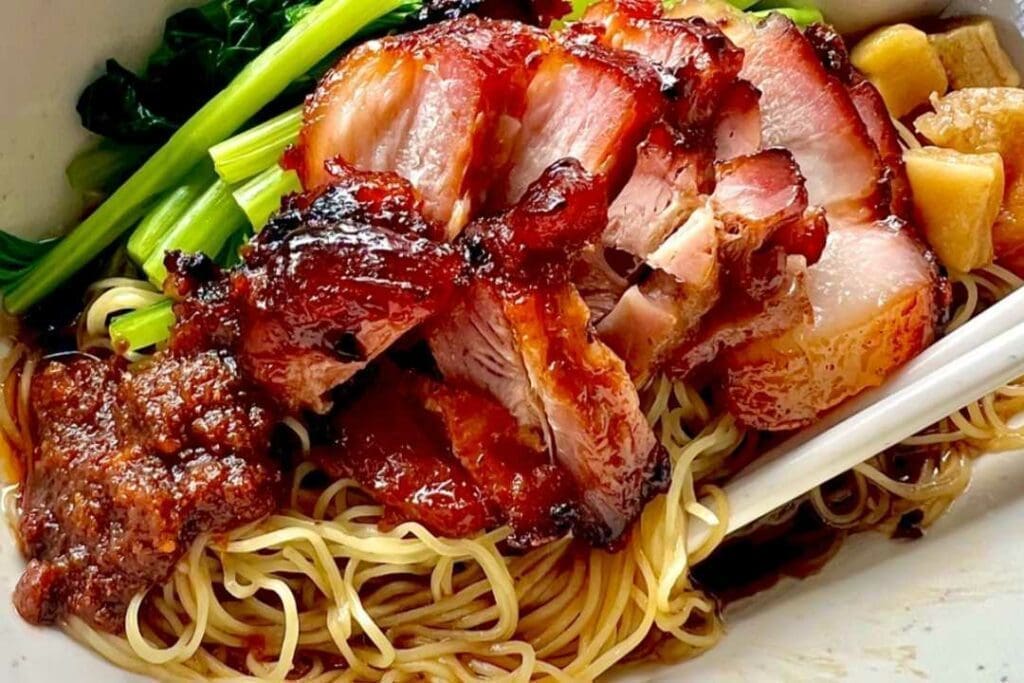

While the dish hails from Guangzhou, China, its journey in Singapore has seen adaptations suited to local palates, resulting in variations that range from the spicy to the subtly sweet.
📍 Where to eat Wanton Mee in Singapore: Chef Kang’s Noodle House and Bei-Ing Wanton Mee
39. Chilli Crab
A masterpiece of flavors, Chilli Crab features meaty crabs smothered in a tangy, spicy, tomato-based sauce. Often mopped up with mantou (fried buns), it’s a messy, finger-licking treat.
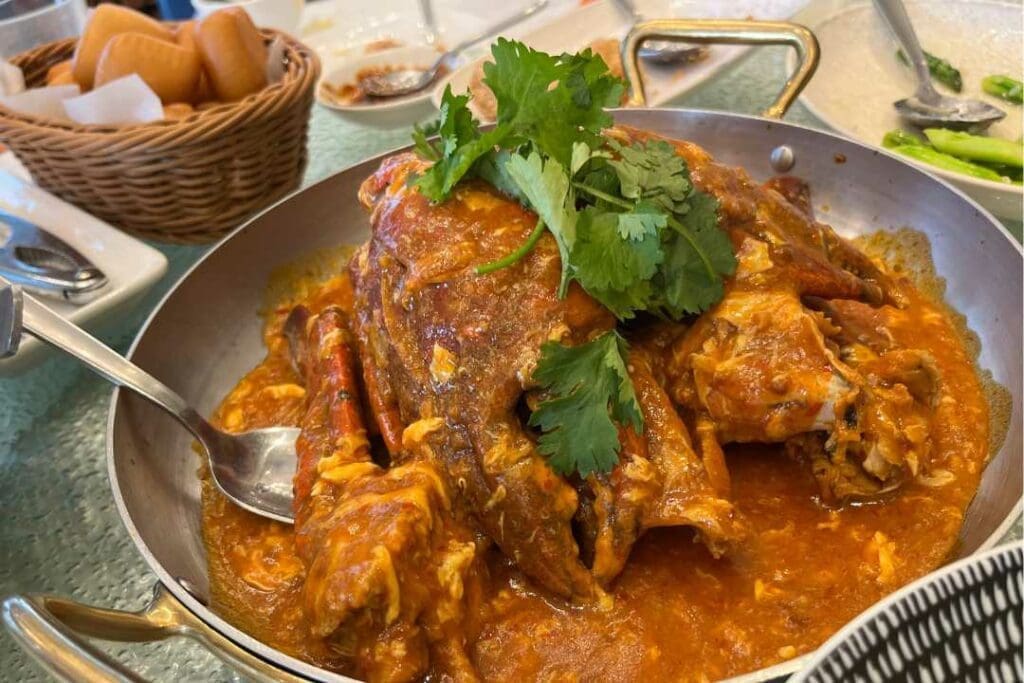

Created in the 1950s, this dish encapsulates Singapore’s culinary spirit — fearless innovation. From pushcarts to upscale restaurants, Chilli Crab’s ascent charts the nation’s own meteoric rise on the global stage.
📍 Where to eat Chilli Crab in Singapore: Jumbo Seafood Restaurant and Long Beach Seafood Restaurant
🍜 Regional cuisines of Singapore
Chinese food in Singapore
Brought by the large influx of Chinese immigrants, primarily from Fujian, Guangdong, and Hainan, in the 19th and early 20th centuries, this cuisine evolved in Singapore, adapting to local ingredients and palates while maintaining its distinct Chinese identity.
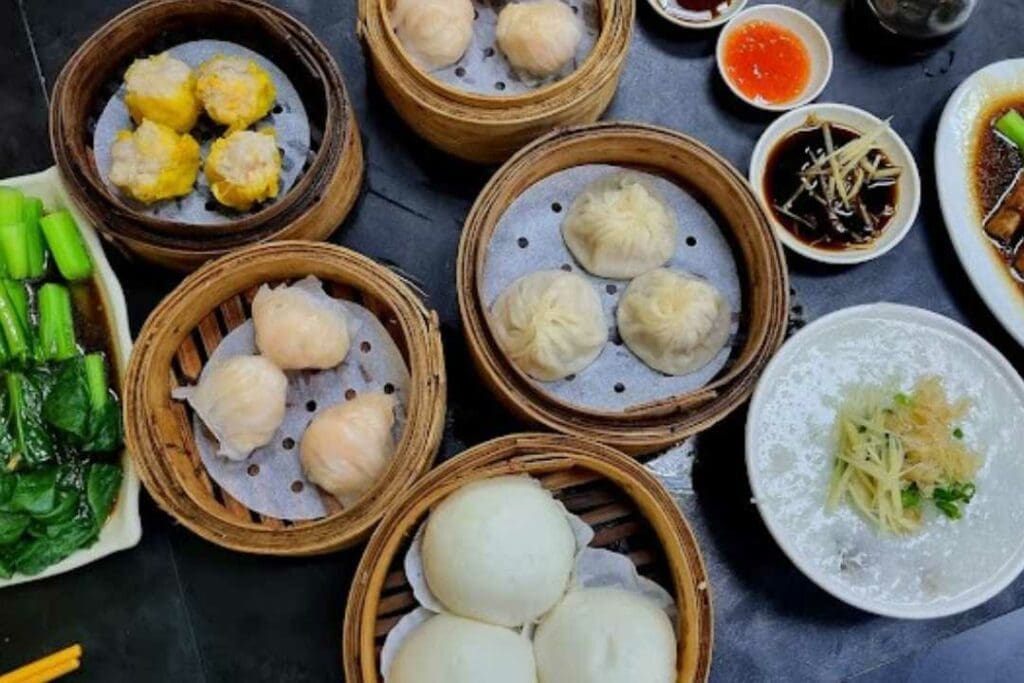

Dishes often spotlight stir-frying, steaming, and deep-frying methods, with rice as a staple. From delicate dim sum morsels to hearty Hokkien Mee, the cuisine is vast and varied, celebrating various ingredients and techniques.
Malay food in Singapore
Rooted in the traditions of the indigenous Malays of the region, Malay cuisine in Singapore has evolved through interactions with neighboring cultures, bearing imprints of trade and migrations while retaining its core culinary ethos.
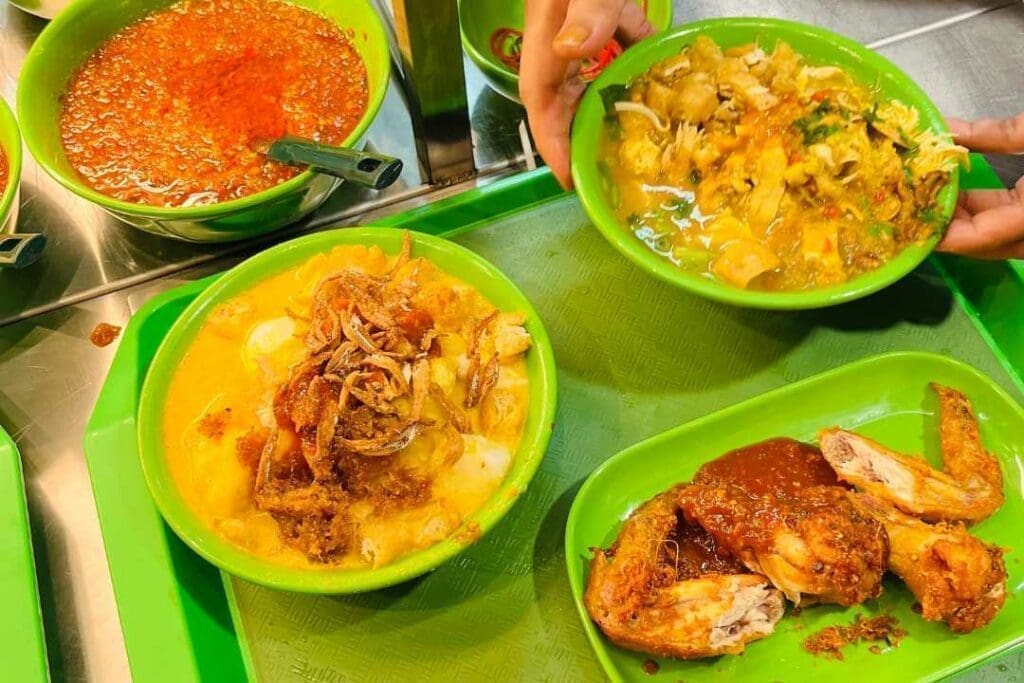

A symphony of sambals, curries, and grilled delicacies complements staples like rice and noodles.
With a focus on aromatic and richly spiced foods, the cuisine emphasizes the balance of flavors – sweet, sour, spicy, and savory.
Indian food in Singapore
Indian traders and laborers, arriving from various parts of the Indian subcontinent, introduced their diverse culinary traditions.
Over time, these recipes melded with local flavors, leading to distinct variations, such as the Indian-Muslim-influenced dishes.
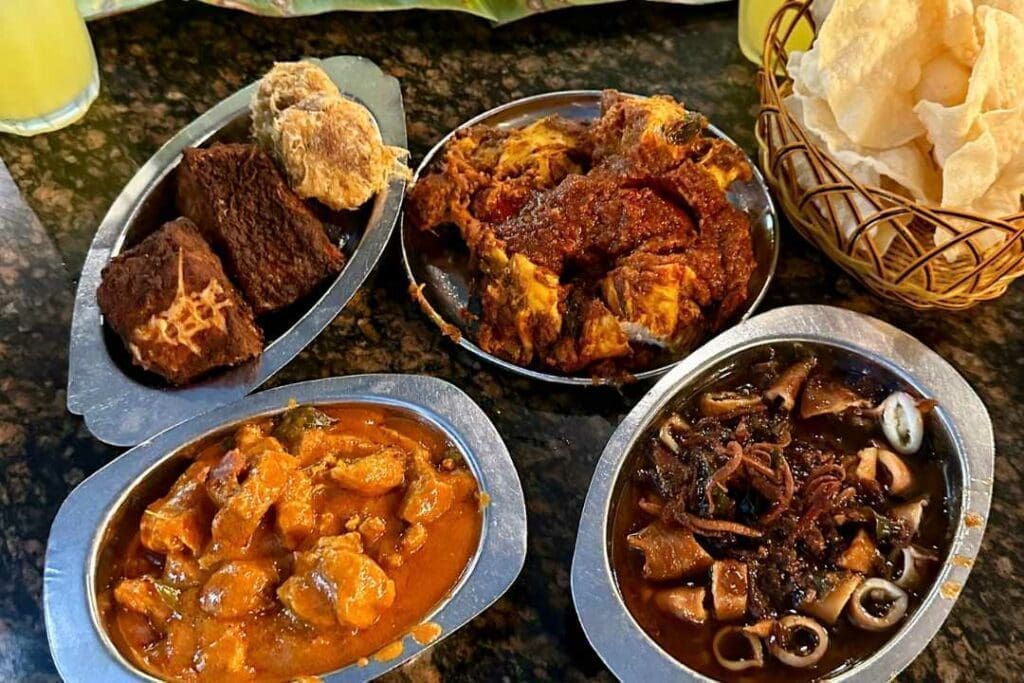

Indian cuisine in Singapore bursts with a cornucopia of flavors, textures, and aromas. It spans the spicy, tangy curries of the south to the rich, fragrant gravies of the north.
Tandoori meats, biryanis, dosas, and chapatis have all found a home here, often served with a medley of chutneys and pickles.
Eurasian food in Singapore
The Eurasian community, descendants of marriages between European colonizers and Asians, birthed this unique cuisine.
It is a testament to Singapore’s colonial past, showcasing a harmonious culinary melding of two worlds.
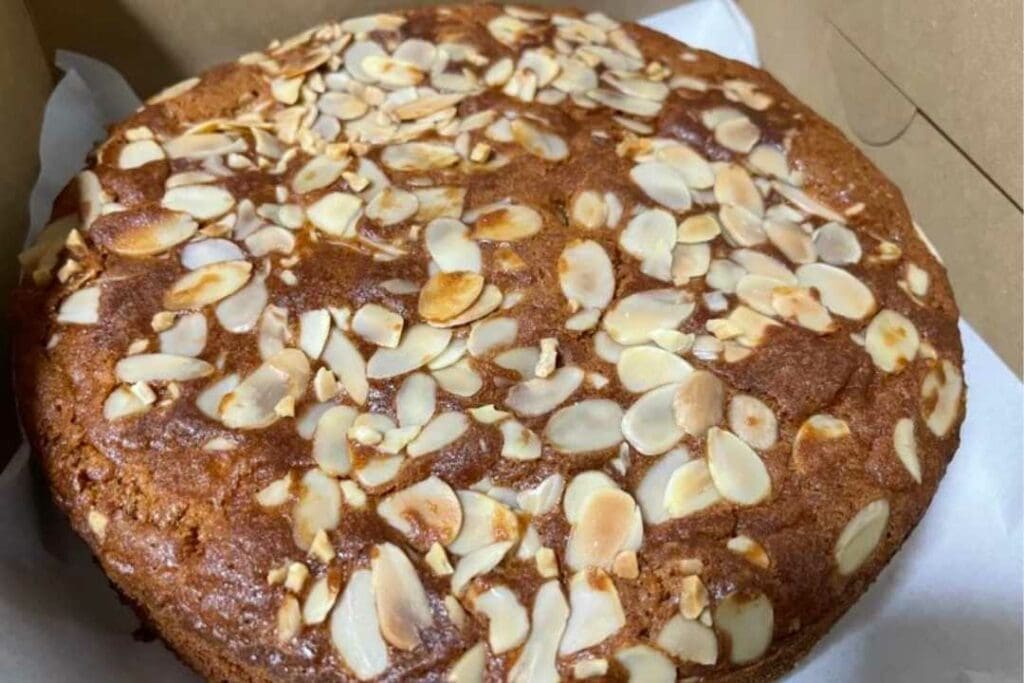

Eurasian cuisine is an intriguing blend of East and West. With European foundations, mainly Portuguese, it infuses Asian flavors, techniques, and ingredients.
The result is a captivating array of dishes, from spicy meat stews like Devil’s Curry to delectable desserts like Sugee Cake.
Peranakan or Nonya Cuisine
Originating from the Peranakan community, descendants of Chinese settlers who married Malay or Indonesian locals, Nonya cuisine encapsulates the blending of cultures over centuries.
It vividly represents the intertwined history of Singapore food and the ability to harmonize diverse influences.
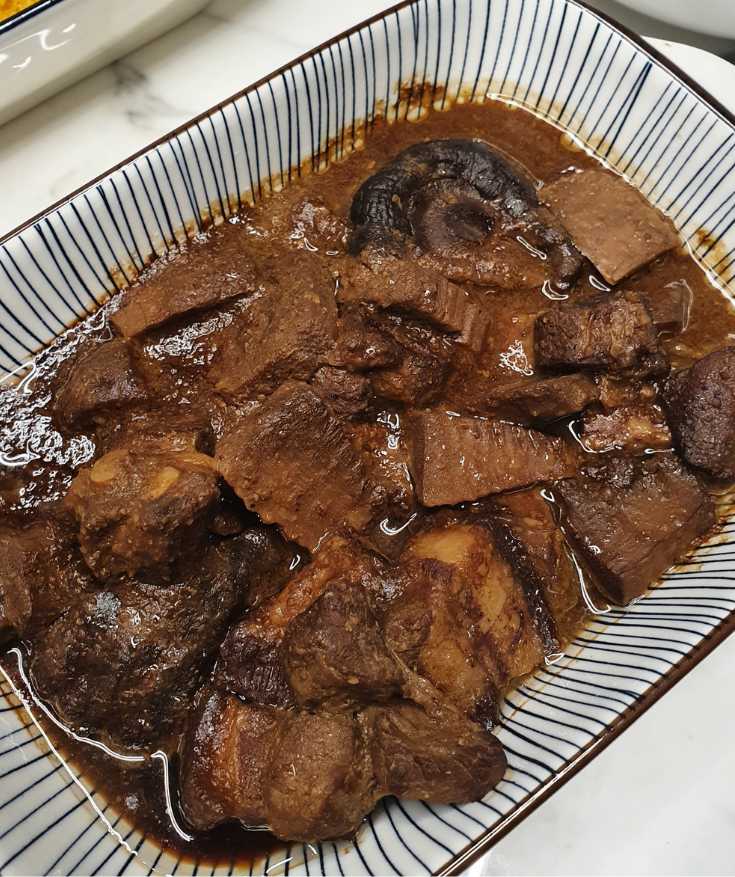

Peranakan cuisine, known as Nonya cooking, is a colorful mosaic of Chinese and Malay culinary traditions.
It’s characterized by its intricate preparation methods and distinctive ingredients like buah keluak and bunga telang. Dishes, often slow-cooked, are aromatic, spicy, and layered with flavors.



